Category GB
In the long term, anything that is not sustainable has only one option: vanish.
Content on this page:
- Achieving net-zero carbon dioxide emissions by 2050
- Digital (energy) madness
- How 2000-watt-neighborhoods reduce power consumption
- Political discourse and reality
- Preferred values of a democratic 2000-watt-society
- Challenges for democratic societies
- Photos of 2000 watt neighborhoods
- Interview with Nate Hagens "The Realities of Living a Low(er) Energy Lifestyle" (YouTube)
Achieving net-zero carbon dioxide emissions by 2050
In our industrialized societies, fossil and electric energy is everywhere. The not yet translated German and French books shows how our modern societies can succeed the transition to a post-oil society without too much turmoil. The challenges are numerous and some are gargantuan, above all if global warming is to be limited to 2°C. But the “2000-watt-neighborhoods” in Switzerland show a promising path towards a post-oil society. A permanent power-consumption of 2000 watts (48 kWh per day) by each human is considered to be sustainable and can be produced by renewable energies. The current power consumption between 5000 and 10 000 watts in industrialized nations is not sustainable. If we accept global warming exceeding 3°C and all the catastrophes and costs that will come with it, such a high level of power consumption may last for another 30 years, till most reserves of crude oil and natural gas will be exhausted and the gap of lower fossil fuel production is filled by added renewable and nuclear energies.
The following graphic shows the historical evolution of the use of primary fossil energy, converted to Tera-Watt-Hours (TWh) :
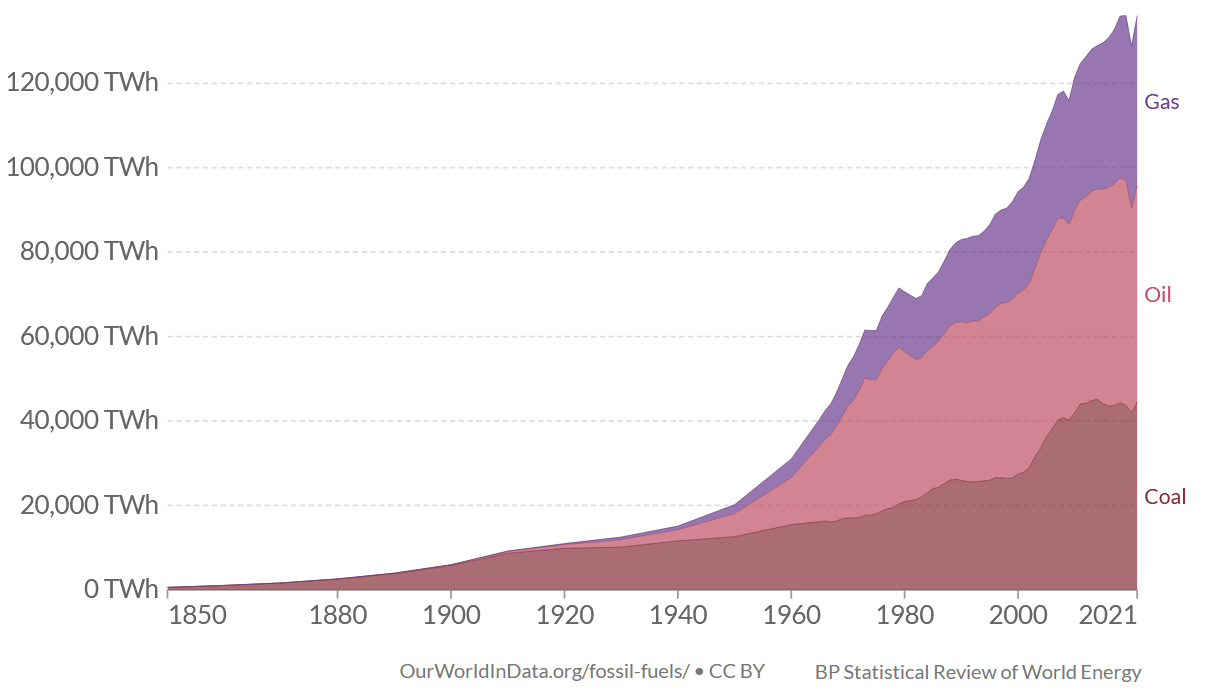 The graph shows the evolution of fossil energy consumption. Greenhouse gas emissions follow the same curve. Growth inversions on this graph show the major economic crises (oil-crisis, financial crisis, Covid-19 pandemy). The global climate summits have not reduced the use of fossil fuels. Their use was almost doubled since the second climat summit of 1990 to reach a new record of 137'000 TWh in 2023.
The graph shows the evolution of fossil energy consumption. Greenhouse gas emissions follow the same curve. Growth inversions on this graph show the major economic crises (oil-crisis, financial crisis, Covid-19 pandemy). The global climate summits have not reduced the use of fossil fuels. Their use was almost doubled since the second climat summit of 1990 to reach a new record of 137'000 TWh in 2023.
These 134 000 TWh of primary fossil energy correspond to about 100 000 TWh of useful carbon-free electric energy if all industrial processes and human activities were changed to carbon-free energy sources. The book shows that humanity doesn't have the means to replace all fossil fuels with renewable or zero-carbon energies till 2050. The cost (CAPEX) is simply too high to be socially acceptable. According to our rather optimistic estimates, worldwide investments of over 260 000 billion (US billion=109) dollars would be needed to replace all fossil fuels with renewable energies and energy storage. For the European Union, investments of 60 000 billions would be needed. The cost calculations already take into account a steady cost-reduction for renewable energies and energy storage. By way of comparison, 260 000 billions corresponded to 350 years of investments of the entire oil and gas industry or to three times the sum of the bond-debts of all countries and companies of the world in 2020. The detailed calculations and estimates of investments to replace all fossil fuels can be downloaded from the “Download” menu.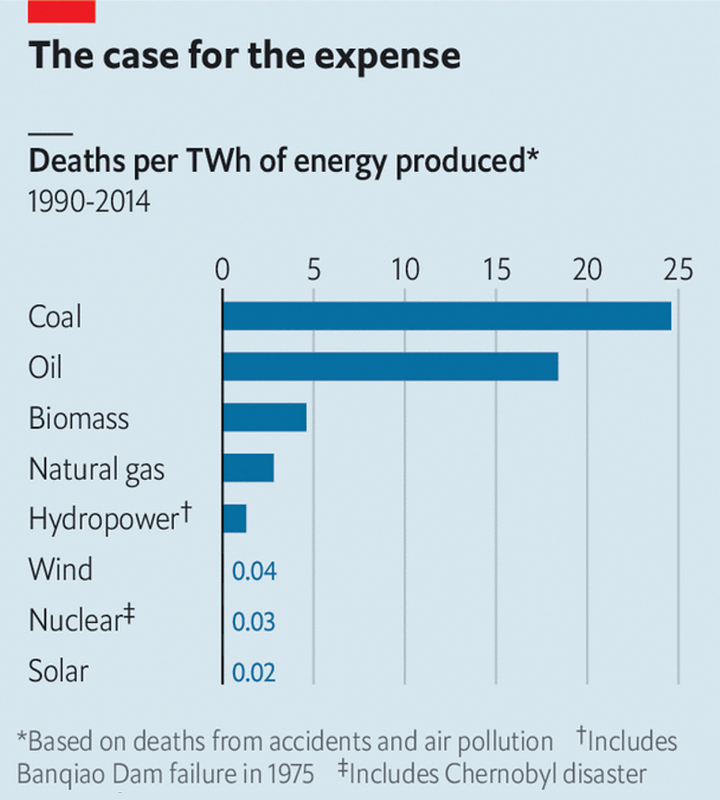
Due to the high costs of renewable energies, no operational nuclear power plant should be shut down for ideological reasons before climate neutrality has been achieved! In the case of radioactive nuclear waste, we are not sure whether final storage in deep layers of the earth will cause any unforeseen problems during the next 1000 years. However, for every megaton of CO2 emitted by a gas or coal-fired power plant, we are certain that it will cause global warming over the next 1000 years. Like all oxides, carbon dioxide is an extremely stable molecule. It takes about 10 000 years for 90 % of a megaton of CO2 to disappear from the atmosphere.
If investments in the energy sector are tripled, the European Union (EU) will be able to replace about a third of its fossil fuels with renewable energies over the next 30 years. Furthermore, if no nuclear power plant is closed, we may create the 2000-watt society and carbon neutrality by 2050. The book shows that the 2000-watt-society is a reasonable goal if we multiply the investments in the energy sector by three[1] and at the same time divide the energy consumption by two or three. The book expects constant technological progress but no "technological miracles" since R&D spending in power and energy storage is much too low, only about 0.005% of GDP in the most industrialized countries [2].
The 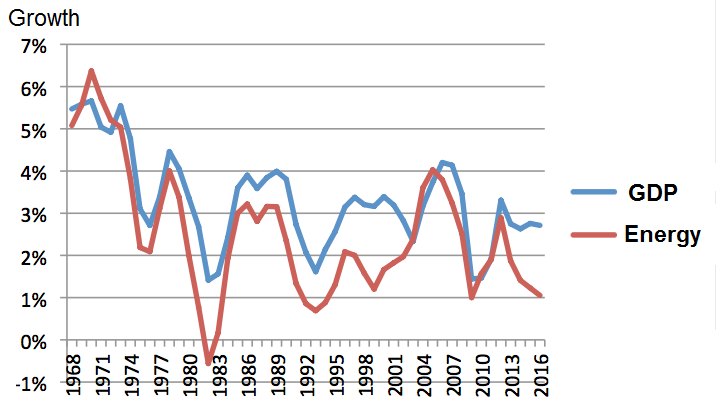 Correlation between growth and energy consumption. Source : OurfiniteWorld.com Meadows from the MIT showed the same correlation in his book "Limits to growth", published in 1972.book shows that humanity may have the means to replace a third of all fossil fuels, the rest must be done by reducing energy needs, improving energy efficiency, and reducing the purchase of energy-hungry objects and services. The book shows also that there exists a strong correlation between energy consumption and GDP since our income depends largely on the number of machines that are working for us, very visible in highly automated factories. Therefore, reducing energy consumption will automatically reduce GDP and therefore reduce the average individual income. This is one of the reasons why moving to the post-oil society may increase the already strong tensions within our societies. If our democratic societies do not organize themselves differently, for example like the 2000-watt neighborhoods, these conflicts may tear our democracies apart and put an end to our prosperity. The financial challenges are such that during the transition to the post-oil society, we will still need nuclear power stations and we have to keep existing nuclear power plants working as long as their safety can be guaranteed. Closing nuclear power plants for ideological reasons is proof of ignorance of the financial challenges for achieving net-zero carbon emissions [3] while maintaining a decent way of life.
Correlation between growth and energy consumption. Source : OurfiniteWorld.com Meadows from the MIT showed the same correlation in his book "Limits to growth", published in 1972.book shows that humanity may have the means to replace a third of all fossil fuels, the rest must be done by reducing energy needs, improving energy efficiency, and reducing the purchase of energy-hungry objects and services. The book shows also that there exists a strong correlation between energy consumption and GDP since our income depends largely on the number of machines that are working for us, very visible in highly automated factories. Therefore, reducing energy consumption will automatically reduce GDP and therefore reduce the average individual income. This is one of the reasons why moving to the post-oil society may increase the already strong tensions within our societies. If our democratic societies do not organize themselves differently, for example like the 2000-watt neighborhoods, these conflicts may tear our democracies apart and put an end to our prosperity. The financial challenges are such that during the transition to the post-oil society, we will still need nuclear power stations and we have to keep existing nuclear power plants working as long as their safety can be guaranteed. Closing nuclear power plants for ideological reasons is proof of ignorance of the financial challenges for achieving net-zero carbon emissions [3] while maintaining a decent way of life.
Despite their sharp decline in energy consumption, the most advanced 2000-watt neighborhoods have a good standard of living, even after freely lowering their individual purchasing power.
Increasing energy efficiency through technological progress contributes to reducing energy consumption. Unfortunately, most technological advancements that improve energy efficiency are lost again due to lifestyle changes. According to a report of the International Energy Agency (IEA), humanity would need to improve energy efficiency by 5% per year over the next 30 years in order to achieve net-zero emissions. However, over the past 20 years, average energy efficiency improved by 1.5% only, and we only did the easy improvements so far. The book analyzes this problem and proposes solutions. Technological solutions alone will not get us to net-zero emissions!
CAPEX investment needed to replace 90% of fossil fuels by renewable and nuclear energy. Also included are hydrogene production for inter-seasonal storage and for steel production with direct-reduction process. Also included are investments in smart-grid infrastructure to tripple transport of electricity. Details available in Download menu.
Worldwide investments to produce and store energy : $ 240 000 billion
Europe's investments to produce and store energy : $ 55 000 billion
Total debt of all countries and companies (bond market): $ 100 000 billion dollars
The estimates above are based on the optimistic scenario of the NREL (National Renewable Energy Laboratory). The optimistic scenario assumes that there will be no shortage of raw materials and metals for the next 30 years and that the cost of energy to manufacture renewable energy equipment and its storage does not increase. Half the cost of solar panels and batteries is determined by the price of raw materials and the IEA predicts a shortage of raw materials between 2025 and 2030. Our estimates are therefore really optimistic. With the pessimistic scenario, the above numbers would have to be doubled. So even if the optimistic scenario shows amounts of investment beyond our socially acceptable means, a paradigm shift is needed if we want to avoid global warming exceeding 3°C !
Digital (energy) madness
The book also shows that 5G telephony, the interconnection of billions of new objects and the multitude of new Internet functions brought about by 5G and artificial intelligence (AI), will rapidly increase electricity consumption. According to forecasts by the International Energy Agency (IEA) and a study by Anders Andrae, an engineer at Huawei, this increase will go much faster than the electricity produced by new renewable energy. The new renewable energy installations will therefore not replace fossil energy, they will not even be able to supply electricity for the new 5G and new Internet functions [4]. Already in 2021, all data-centers in the city of Frankfurt consumed 1.6 times more energy than the city's 400,000 households (FAZ, Serverfarmen in der Stadt, 10/17/2021). Further data-centers are under construction even in that city.
Suppose that the number of searches made with systems like Chat-GPT4 one day equals those made by search engines like Google, Baidu or Qwant. In this case, the data centers of Chat-GPT4 and its competitors would consume the energy of 20 nuclear power plants. Details are available in the Download menu in an Excel file. Chat-GPT type of AI will only marginally increase work productivity, since the productivity gains of writers and journalists will be offset by the increasing number of fact-checkers needed to keep democracy alive. Many professions like lawyers use their own up-to-date AI based expert systems and don't really need Chat-GPT's outdated content, nor do they want the bias-producing internal preprompts that Chat-GPT needs in order to avoid inspiring criminal activities.
The energy balance becomes even more negative with Virtual Reality projects also called "metavers". The metaverse is a virtual representation of physical reality, for example streets, landscapes, shops, clubs and museums. The connection to the "metaverse" will usually be through a 3D virtual reality headset that records and sends people's movements, images and words to a data center. The "metaverse" will thus allow friends, each in their home with a virtual reality headset on their head, to take virtual walks together, as if they were walking together in a city on Google street-view, or as if they visited the Louvre Museum virtually together. In all these places, they will be able to virtually meet people who also walk around the Louvre virtually. As in real life, by paying with real euros, friends will be able to buy virtual luxury gadgets to impress the virtual people they meet in the "metaverse". These "metaverse" projects will produce unimaginable amounts of data streams and increase electricity needs accordingly. Not to mention the loss of the last place of privacy in our own homes. Activities in the "metaverse" will not diminish tourism, they will increase it, just as television documentaries have. The beauty of exotic countries attracted ever more tourists.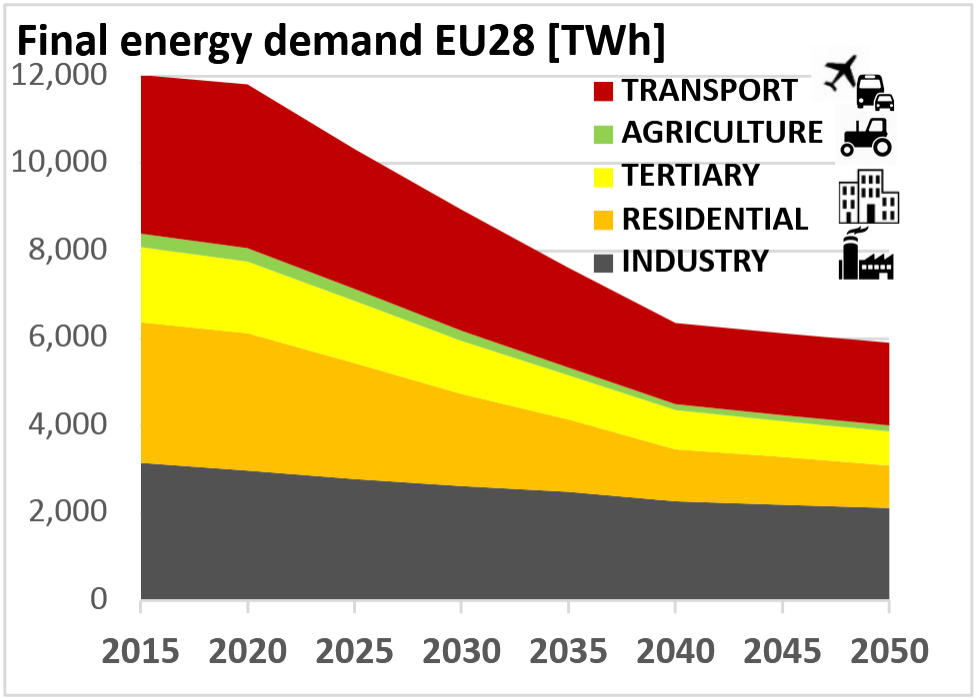 Source: Energy consumption pathway of the European Union. The total final energy of 6000 TWh is an equivalent of 1800 watts of permanent average energy use per capita. This graph does not include indirectly imported grey energy.
Source: Energy consumption pathway of the European Union. The total final energy of 6000 TWh is an equivalent of 1800 watts of permanent average energy use per capita. This graph does not include indirectly imported grey energy.
The miniaturization of electronic components will reach the limits of physics (end of Moore's law). From around 2026, the energy efficiency of data-centers will only improve marginally and their electricity consumption will then increase expontntially like the volume of data.
All these developments are in contradiction with the government's announcement to want to achieve net-zero carbon in 2050. Unfortunately, political and economic decision-makers ignore this "energy" parameter, although it is the basis of our industrial civilization. If we do not give the energy factor the highest priority in our political, economic and consumer decisions, we will end up with a global warming between 3°C to 4°C.
For all of these reasons, energy use has to be reduced by about the amount that the Swiss, French and German official energy paths show.
If the rich countries decide to maintain their average permanent energy consumption of about 6000 watts with investments into carbon-free power utilities exceeding 10% of the GDP, they will never be able to convince less rich countries to give up fossil fuels, because the cost of fossil fuels drops if rich countries consume less and less. To decarbonize their economies, developing countries need help from rich countries, as rich countries import all kind of products from countries with low labor costs. Indonesia, for example, has pledged to reduce CO2 emissions by 41% until 2030 if it receives aid from rich countries, but only by 29% without such aid.
How 2000-watt neighborhoods reduce power consumption
Regarding energy consumption, several 2000-watt-neighborhoods, managed by housing cooperatives, have considerably reduced their energy footprint. Without taking into account the energy needed for state infrastructure and services, some neighborhoods have almost reached the goal of 2000 watts of permanent energy consumption, which corresponds to about a third of the Swiss average in 2010. The book describes methods by which these neighborhoods achieve the goal of energy consumption of 2000 watts. This reduction in energy consumption is also the best response to global warming and social justice.
The buildings of the 2000-watt neighborhoods consume very little energy (10 to 12 kWh/m²/year), about 15 times less than the American average. The construction-costs are only 10% higher than Swiss average. Everything is optimized for low energy consumption, starting from the choice of building materials, architecture, ventilation, space optimization, etc. The book explains the most important points. A specialized book for architects illustrates and explains the details that make such extremely low energy consumption possible. It is available in the download menu.
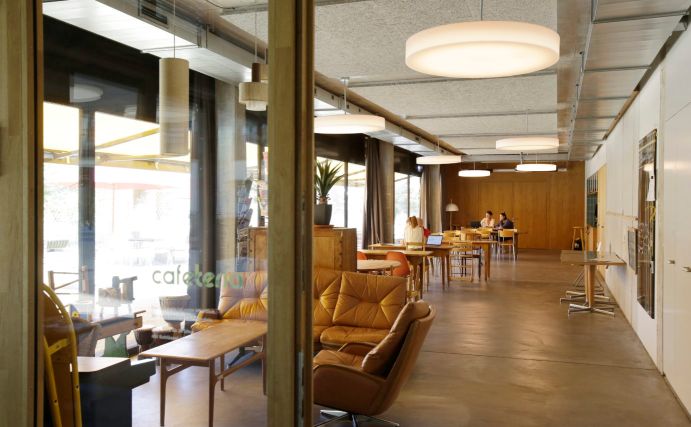 Cafeteria reserved for the inhabitants of the 2000-watt neighborhood Kalkbreite
Cafeteria reserved for the inhabitants of the 2000-watt neighborhood Kalkbreite
Considerably reducing energy consumption also implies reducing individual purchasing power. In order to maintain a good standard of living, the inhabitants of the 2000-watt neighborhoods share many objects and infrastructures such as repair workshops, a sewing workshop, laundry rooms, tiny apartments for guests, meeting and party rooms, a sauna, a library, but also cars and electric bikes belonging to the housing cooperative. The neighborhood also facilitates sharing of children's clothes, books and games when a family no longer needs them because a child has grown up. In principle, they share quality objects and infrastructures that are not often used by each inhabitant.
Let's suppose that 32 families in a 2000-watt neighborhood share 4 large professional washing machines, each one having a lifespan of 24 years. Manufacturing a professional washing machine needs about twice as much energy as manufacturing a family washing-machine. Let's compare the gray energy of these 4 professional machines with the 32 washing machines, one per family, of which each machine has an average lifespan of 7 years (average lifespan in France). Then, for the object washing machine, the grey energy of the inhabitants of a 2000-watt neighborhood is divided by 14 compared to the average household in France. With things that are used even less often, such as "do it yourself" tools and sewing machines, the grey energy saving is even more important. The book develops all the aspects of 2000-watt neighborhoods that allow energy savings without losing quality of life. Other aspects concern food, buildings, mobility, leisure time, social life of neighborhoods in the event of an epidemic and relations between big cities and rural communities.
However, if the savings made in the areas of housing and daily mobility are spent to consume more stuff, the energy balance does not really improve. For this reason, the book reflects on how to reduce the attraction of money and its power on the human mind, inspired by the practices of the most advanced 2000-watt neighborhoods. Our purchasing power, energy consumption and environmental footprint are closely linked. (Some further explanations in the menu "The book").
The table below shows the average permanent primary energy consumption per capita, without gray energies needed to create and maintain public infrastructure:
Swiss average per capita: 7000 watts(a) Residential only: 2000 watts
Advanced 2000 watt neighborhoods: 3500 watts(b) Residential only: 600 watts
(a) Swiss government data (b) included are 1300 watts for state infrastructure and services
In many countries, residents' cooperatives are very similar to the 2000-watt neighborhoods in Switzerland. If the buildings of these residents' cooperatives comply with the Swiss standard "Minergie-Plus-Eco", which is not easy, they can achieve the same energy performance as 2000-watt-neighborhoods in Switzerland. Like the 2000-watt neighborhoods in Switzerland, residents' cooperatives can reduce the use of gray energy by sharing infrastructure and objects. To continue advancing towards a lifestyle compatible with carbon neutrality, having a quantified and measurable goal (2000 watts) could be a source of inspiration for residents' cooperatives or for any other neighborhood trying to find a carbon-neutral lifestyle. Some advice on this subject can be found in the menu "Download, section Building and Standards".
Will the 2000 watt society create unbearable increase of unemployment ? Let us stick to the example of washing machines. Producing a small quantity of machines (8 times less in the example above) no longer justifies strongly automating factories, which saves energy. Creating very high quality products with a long lifespan requires well-skilled workers. Therefore, producing very good quality machines in smaller quantities saves energy and creates jobs. High-quality machines are more expensive, but the budget is shared since several households share a machine. If, moreover, equality between humans is oriented towards energy consumption, the salaries between the highest and least qualified people will automatically become smaller since material extravagances will cease to be symbols of social success and become a status for the destruction of the planet. However, the rich willing to do their fair share will still be able to buy luxury goods such as handmade mechanical watches, since making such a watch consumes much less energy than producing an electronic Apple-Watch.
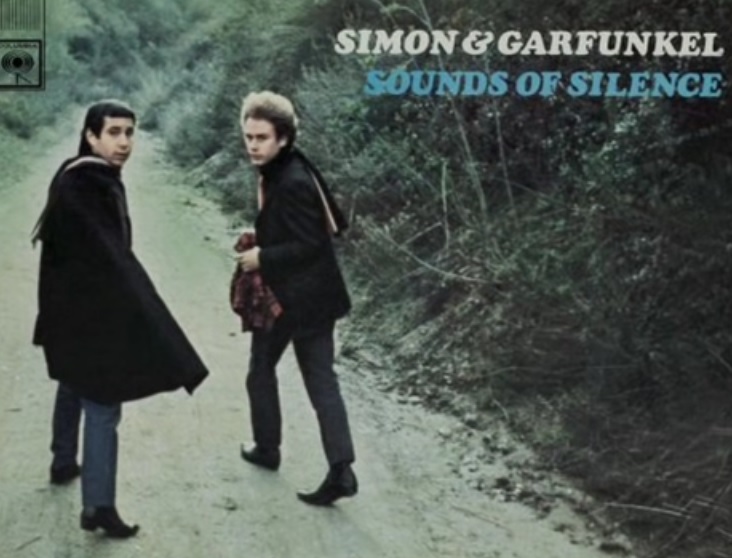 Simon & Garfunkel: I am a rock, I am an island 2000-watt neighborhoods are not a panacea for all human problems. The book describes some problems encountered in these neighborhoods and the implemented solutions. For sure, other problems will emerge in the future. In this context, it can be useful to know that there are notions of freedom, equality, fraternity and justice which make living together more or less conflictual. The book offers reflections on these notions, since living together and sharing objects in peaceful neighborhoods can not be taken for granted. Our individualistic societies will have to relearn how to live together and peacefully manage conflicts between neighbors. Only the abundance of cheap energy allowed us to live alone, caring for nobody, like "a rock that feels no pain and an island that never cries" (Simon and Garfunkel).
Simon & Garfunkel: I am a rock, I am an island 2000-watt neighborhoods are not a panacea for all human problems. The book describes some problems encountered in these neighborhoods and the implemented solutions. For sure, other problems will emerge in the future. In this context, it can be useful to know that there are notions of freedom, equality, fraternity and justice which make living together more or less conflictual. The book offers reflections on these notions, since living together and sharing objects in peaceful neighborhoods can not be taken for granted. Our individualistic societies will have to relearn how to live together and peacefully manage conflicts between neighbors. Only the abundance of cheap energy allowed us to live alone, caring for nobody, like "a rock that feels no pain and an island that never cries" (Simon and Garfunkel).
Political discourse and reality
In 1992 in Rio de Janeiro, most nations decided to reduce the environmental impact of human activities and greenhouse gas emissions [5] in order to maintain biodiversity to reduce climate change. In 1997 in Kyoto, Japan, this decision was reinforced. In 2009 in Copenhagen, most nations decided to limit global warming to 2°C, and in 2015 in Paris, they decided to aim for global warming below 2°C. But since humanity decided to drastically reduce greenhouse gas emissions in 1992, it has not reduced them, it has doubled them! It is therefore obvious that the materialist philosophy, which is dominant as much in China as in the West as elsewhere, does not help people to limit themselves before we all together hit the limits of the planet. Hitting these limits at full speed of GDP growth will produce a lot of upheaval, starvation and other miseries.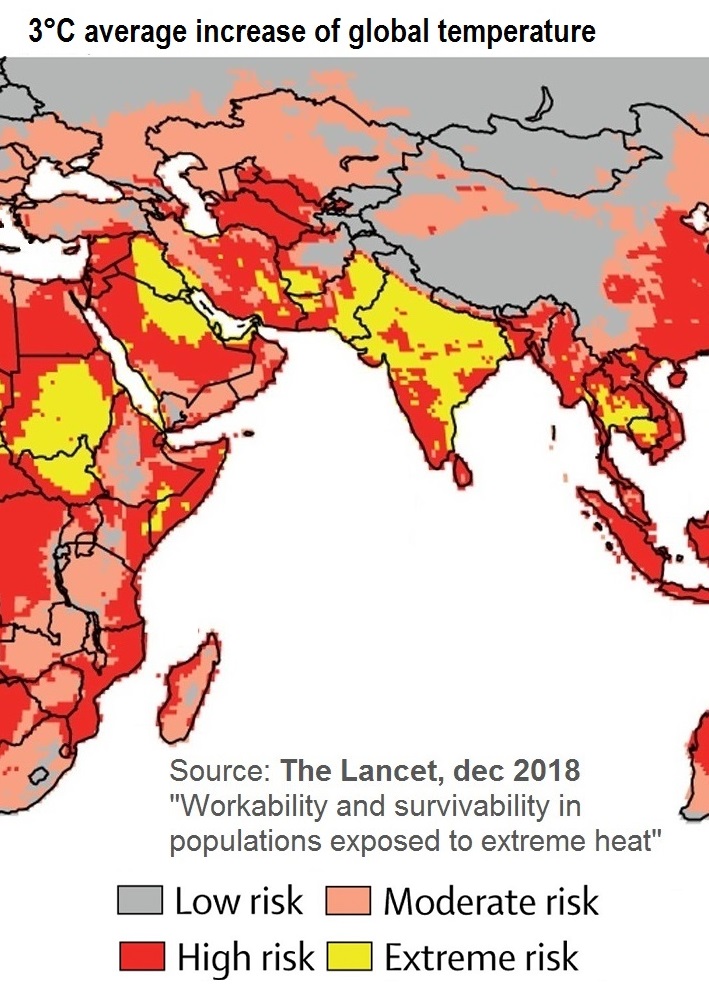 In the yellow zones live 1 billion humans.
In the yellow zones live 1 billion humans.
It is therefore essential to think about human values which encourage people to freely limit themselves. It is important to think about human values and priorities that encourage self-limitation and yet allow scientific progress. Self-limitation means voluntarily limiting one's purchasing power and exercise of power over nature and fellow human beings. The dominant values of the last half a century have to change. We need a philosophy that prefers human relations over an ever-increasing amount of material goods, prefers quality to quantity, values serenity more than emotions from speed, and sees in nature more than a means to get rich while assuming the right of its free exploitation.
Looking at the evolution of industrialized nations since 1992 makes it difficult to see how a voluntarily materialistic philosophy could produce a society that values relationships and serenity more than stuff, machines, data centers and transhumanist gimmicks. According to the most probable scenario of Bloomberg's New Energy Outlook (NEO 2020), the current system logically leads us towards a global warming of 3°C by 2100, compared to a warming of 1.2°C during the last 150 years. Under this scenario and given the inertia of the climate system, global warming is likely to stabilize close to 3.5°C, producing ever more extreme weather conditions. The cost of adapting to extremer weather will be much higher [6] than building the 2000-watt society.
Humans do not survive with temperatures above 35°C and humidity above 90% (or 39°C and 50%), which will be the case in large parts of India, Pakistan, the Middle East and South America. A medical study published in The Lancet shows that about a billion people will live in places that become uninhabitable for several months each year. With an average temperature increase of 3°C, temperatures above the sea will increase by 2.5°C and about 4.5°C on the mainland.
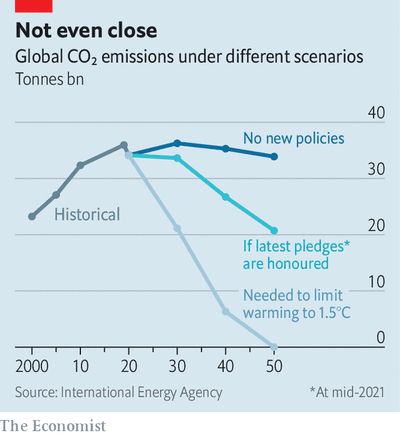 Equally alarming is the latest report from the Intergovernmental Panel on Climate Change (IPCC). Even if the States respect their commitments made at COP21 in Paris, which is currently not the case, the planet would warm by at least 3°C by 2100.
Equally alarming is the latest report from the Intergovernmental Panel on Climate Change (IPCC). Even if the States respect their commitments made at COP21 in Paris, which is currently not the case, the planet would warm by at least 3°C by 2100.
In 2020, during the Covid-19 epidemic, many states announced that they wanted to invest a total of $ 16 000 billion for economic recovery. In a special report, the IEA proposed that a quarter of this huge amount be used to invest in renewable energy utilities. In July 2021, the IEA finds that only 2% of the 16 000 billion is forecast for renewables and that CO2 emissions are likely to reach a new record in 2023.[7] According to the 2015 Paris agreements, CO2 emissions should decline by 20% until 2025, but instead, humanity will likely set a new CO2 emissions record. It is therefore essential to think about human values which encourage limiting oneself while leaving room for scientific progress.
If we take into account the CO2 balance of the imported and exported products and therefore the imported grey energy, almost all countries are moving in the wrong direction, both capitalist and communist economic systems. Since countries with different political and economic systems move in the same wrong direction, the problem is probably also of a philosophical nature, for a materialist philosophy with a tendancy to transhumanism is more or less dominant in most capitalist or communist countries.
Jacques Ellul writes on this subject in "Living and thinking about freedom" (p.235): "Humans are considered exclusively as consumer-producers. This is, for example, as much the case in the communist materialist doctrine as in American materialist practice. In both systems, humans are instruments of production. And the whole life of man is oriented towards this one goal. ... We do not care about man as a man but as a producer, and all interests about him are not very different from the interests we have in the best machines."
Preferred values of a democratic 2000-watt-society
Reducing energy consumption needs sharing infrastructures and high quality objects in a neighborhood. That in turn requires changes in the dominant values. The individualist consumer-culture is too focused on individual rights and purchasing power. It favors narcissism as narcissists need everything and share nothing. That's good for the GDP, but is not sustainable. A candidate for the presidency of the Republic will never be elected if he promises a steady decline in individual purchasing power over the next 50 years. The consumer culture has almost deified money and purchasing power. The book develops ways for reducing the influence of this pitiless deity. For all these reasons, the book offers a reflection on the motto of the French Republic: liberty, equality, fraternity. Unfortunately, this motto is often used like a publicity slogan. But a good understanding of this motto helps to produce the values that will be essential for living well in a 2000-watt society, without first going through civil chaos and state oppression.
Looking at the evolution of industrialized nations since 1992, it is difficult to see how a deliberately materialistic philosophy could produce a society that values nature, relationships and serenity more than objects, machines, datacenters and transhumanist gadgets. Even after trying hard, I can't see how such a philosophy can encourage a society to freely renounce purchasing power and therefore power over nature, other humans and animals.
Since practical initiatives come from their inhabitants and their work groups, the 2000-watt neighborhoods need freedom. Equal energy consumption dramatically reduces inequalities in lifestyle, an original response to growing inequalities. The current inequalities in our societies produce a lot of mimetic desires (cf. René Girard), which increase the GDP of a wasteful consumer culture, but these desires make reducing energy consumption close to impossible. Fraternity facilitates the sharing of infrastructures and favors collaboration in various work-groups, even between people of different origins, clearly visible in the 2000-watt neighborhoods.
The 2000-watt neighborhoods oppose the materialist philosophy which produces an increasingly individualistic consumer-society, and for which the "good life" consists mainly of purchasing ostentatious goods. Materialism has been spreading for more than 50 years, produced the dominant values in our societies and finds its latest goals in transhumanism. This materialist philosophy has also a very special understanding of the motto of the French Republic. This philosophy ...
- reduces humans to "biological machines", freedom to a wide choice in front of supermarket shelves and "free will" to a psychological illusion (B.F. Skinner, G. Roth, J.P. Changeux);
- considers the equality of humans as an illusion derived from Jewish and Christian myths (Y. Harari) and prefers an egalitarianism whose remote ideal would be the equality of human clones (A. Huxley);
- considers fraternity as a silly anachronism, since human relations are above all determined by the "will to power" (Nietzsche).
The most effective deception of our socio-economic system is to make us believe that personal freedom invites us to do whatever we desire, without thinking about the consequences and without moral considerations. This allows advertisers to manipulate our desires, allows TV stations "to sell available brain-time" (CEO of the French channel TF1 about the efficiency of advertisements) and allows economists to say "household morale is good" because households spend lavishly. This "freedom" is a deception because it is easily manipulated. Such "freedom of desires" requires unlimited growth of consumer-spending and is not sustainable because it will generate ever more serious ecological and social problems. Because of social instability, that type of "freedom" can eventually be used as a pretext to reduce the freedom of all. An IEA report from May 2021, of which Chapter 5 provides a short overview, shows the importance of behavioral changes to achieve net-zero carbon emissions. Chapter 7 of the book offers reflections on a type of freedom that liberates from materialistic consumer-propaganda.
The book proposes a philosophy that allows us to create a democratic post-oil society, in the spirit of the 2000-watt neighborhoods, and guided by a phrase from the philosopher Francis Schaeffer: "Every society evolves slowly, but surely, towards the logical conclusions of its dominant philosophy ".
The materialist philosophy reduces almost everything to its economic utility, proposes to solve social problems mainly through growth of GDP and divides the society into multiple communitarian identities according to the principle "Divide et impera", divide and conquer (Machiavel). For the last 20 years, many American universities have been teaching theories that divide society into a multitude of more or less irreconcilable communities. It should therefore come as no surprise that today, large urban centers in the United States are more segregated and fractured than in 1990 [8]. Mutual ignorance and hatred between communities is steadily increasing, or as political scientists call it, "affective polarisation" increases [9]. Several studies have shown that about 70% of American college students have more narcissistic traits and less empathy than 30 years ago [10]. The book shows the consequences of this philosophy and makes proposals for another philosophy that encourages self-limitation, fraternity and support for the weak of all communities.
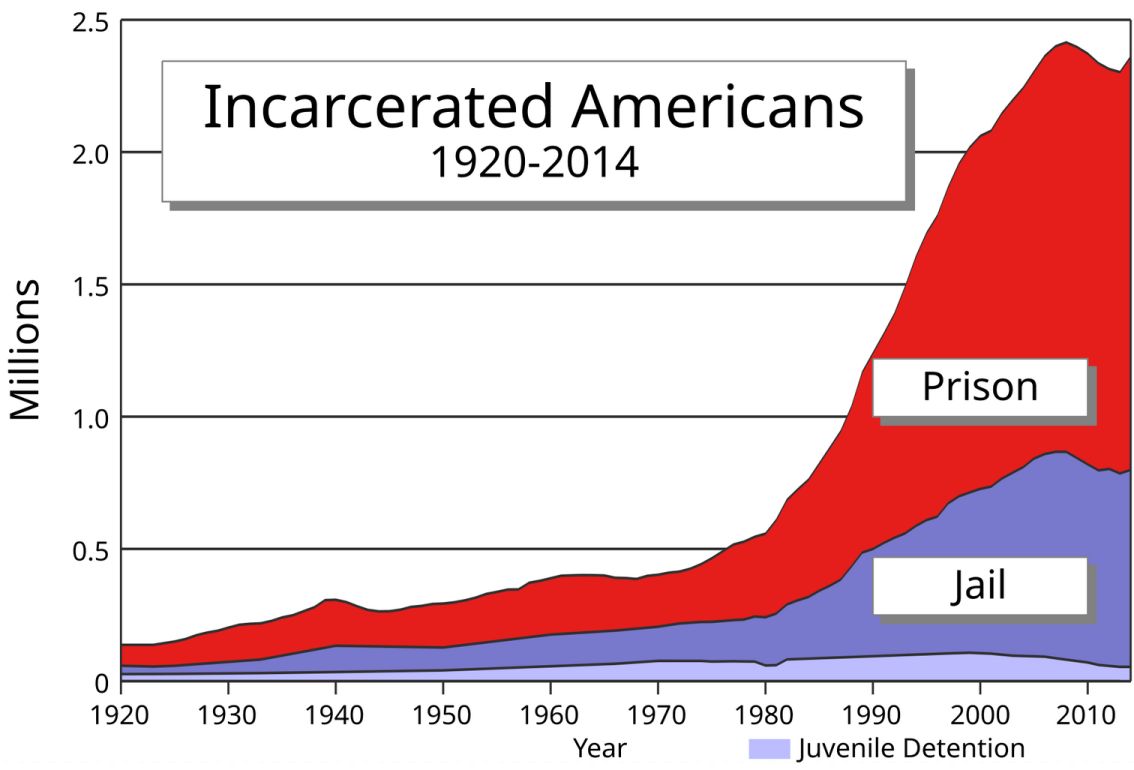 Why does the number of prison inmates correlate to energy consumption and GDP in many rich countries?The number of people in prison increased at about the same level as energy consumption and GDP, but poorer societies can't afford to put so many young and healthy men in prison. Industrial societies are flooded with advertisements that generate all kinds of desires that leave many poor people with ever more frustrations. Furthermore, many people today think of freedom as "following unconditionally one's own desires". Creating huge amounts of desires is good for GDP but bad for everything else, including nature and biodiversity. But artificially creating desires and frustrations to increase consumption is unique in the history of human civilisations.
Why does the number of prison inmates correlate to energy consumption and GDP in many rich countries?The number of people in prison increased at about the same level as energy consumption and GDP, but poorer societies can't afford to put so many young and healthy men in prison. Industrial societies are flooded with advertisements that generate all kinds of desires that leave many poor people with ever more frustrations. Furthermore, many people today think of freedom as "following unconditionally one's own desires". Creating huge amounts of desires is good for GDP but bad for everything else, including nature and biodiversity. But artificially creating desires and frustrations to increase consumption is unique in the history of human civilisations.
Ancient cultures tried to limit desires : do not covet ... (Hebrews), learn contentment (Stoics), be thankful and content with what you have (Christians), all desires are bad for your Karma (Buddhists).
One place in the New York City Rikers prison costs about $200'000 per year, the average cost of a place in a French prison is about €40'000. Shouldn't we think about the usefulness of these "investments" ?
If we understand Justice as an Equality of suffering between victim and perpetrator, we fill prisons without helping the victims. The book shows that we should see "Justice as reparation of the consequences of a crime, restoration of material damage, human suffering and relationships" (see Howard Zehr: Changing Lenses).
The most advanced 2000-watt neighborhoods actively seek cultural, social, economic and generational diversity among their inhabitants, in the pursuite of a common goal: build a piece of the 2000 watt society. The book shows the social and economic benefits of their way of life. Since the poor can't reduce their living standard (energy consumption) very much without starving, socially diverse neighborhoods working together to reach a common goal (2000-watt) can prevent violent social unrest. That's another purpose of the 2000-watt neighborhoods. Either we will succeed to build the 2000-watt society together by cultivating fraternity, or we will fail together with high global warming and all sorts of crises that will tear our ever more fractured democratic societies apart.
 Amish mobilityIn 2020, in the midst of a debate on the adoption of the new 5G phone technology, the President of the French Republic compared environmentalists to the Amish who reject most technical advances. The photos below show that life in the 2000-watt neighborhoods is comfortable and unlike an Amish life-style. Yet, those neighborhoods probably have no more use of the 5G-phones than the Amish do. At the same time, the Amish people we met in the United States seem much happier in their lifestyle than many people in our individualistic consumer societies. In 1965, about 40% of Amish youth left their communities for good, down to less than 5% today, because life in our individualistic societies has probably become much less attractive. (Amish youth has always been encouraged to leave their communities for a period of 3 months to 2 years in order to experience life in society. After that experience, they may freely choose or not to return to their community).
Amish mobilityIn 2020, in the midst of a debate on the adoption of the new 5G phone technology, the President of the French Republic compared environmentalists to the Amish who reject most technical advances. The photos below show that life in the 2000-watt neighborhoods is comfortable and unlike an Amish life-style. Yet, those neighborhoods probably have no more use of the 5G-phones than the Amish do. At the same time, the Amish people we met in the United States seem much happier in their lifestyle than many people in our individualistic consumer societies. In 1965, about 40% of Amish youth left their communities for good, down to less than 5% today, because life in our individualistic societies has probably become much less attractive. (Amish youth has always been encouraged to leave their communities for a period of 3 months to 2 years in order to experience life in society. After that experience, they may freely choose or not to return to their community).
Challenges for democratic societies
 No till "Conservation agriculture" has the potential to store 1 ton of Carbon (3.4 t of CO2) per ha per year in the soil.Societies torn apart by all sorts of conflicts often end up in a political dictatorship or a full-fledged surveillance state. During the last 50 years, the concentration of political and economic power has gradually increased and this process discredits our democracies. At the same time, tensions between major urban centers and the rest of the country are also steadily increasing. As the book shows, such tensions are nothing new. History is full of peasant-wars, and even today, the Chinese metropolis treat migrant rural people really bad, even though these migrant workers build those huge cities. Renewable energy for the cities will be produced in the countryside, and it will not be possible to protect all solar panels and wind-turbines by an armed police.
No till "Conservation agriculture" has the potential to store 1 ton of Carbon (3.4 t of CO2) per ha per year in the soil.Societies torn apart by all sorts of conflicts often end up in a political dictatorship or a full-fledged surveillance state. During the last 50 years, the concentration of political and economic power has gradually increased and this process discredits our democracies. At the same time, tensions between major urban centers and the rest of the country are also steadily increasing. As the book shows, such tensions are nothing new. History is full of peasant-wars, and even today, the Chinese metropolis treat migrant rural people really bad, even though these migrant workers build those huge cities. Renewable energy for the cities will be produced in the countryside, and it will not be possible to protect all solar panels and wind-turbines by an armed police.
Some 2000-watt-neighborhoods also show a way to build bridges over the abyss separating metropolis and the rest of the country. The book shows how they collaborate and build mutual understanding. This collaboration is essential to guarantee sustainable food-production in the post-oil society. Intensive agriculture, which consumes too much energy, is not sustainable. Other forms of agriculture do also store large amounts of CO2 in the soil. Thus, on top of nourishing humanity, agriculture could contribute considerably to the fight against global warming, if only the metropolitan elites treated rural people differently. That is one more area where our choices will have historical consequences. Several 2000-watt neighborhoods, located in large urban centers, show a way forward.
One of the book's hypotheses is that a direct democracy as practiced in Switzerland for the last 700 years strengthens reasonable democratic debate and therefore democracy. Reasonable democratic and contradictory debate is also a bulwark against demagogic power grab. Direct democracy is useful because it helps citizens to learn to think about many sometimes complex issues, to conduct reasonable debates and to feel concerned by the common project of a country. The inhabitants generally take a long-term view on political, economic and environmental issues since they care about the lives of their children and their grandchildren. Politicians tend to take a short-term view that rarely exceeds the length of their political mandate. It should therefore come as no surprise that educated citizens vote for changes that a central and remote government does not dare to force onto its citizens. But would a Swiss-type of direct democracy have a positive educational and pedagogical effect on the people of other nations too, without having to wait for 700 years? The "Vote" menu tries to find an answer to that question.
In the history of mankind, outside of Switzerland, no democracy has reached the age of 300 years. Without the help of the United States, European democracies would have disappeared 80 years ago. Today, at the age of almost 250 years, the American democracy is severely ill since reasonable contradictory debate is on its way out. Even though direct democracy in California looks similar to the Swiss system, it has one substantial difference. The Swiss vote three times each year on about two propositions or referendums. It is possible to have a thorough debate about two proposed laws, but it is not possible to think about all pros and cons and consequences of 20 propositions as is the case in California once every 4 years. As this website shows, Swiss sometimes vote about really complex issues that need thorough debate and thinking. Most human minds are simply not capable to handle 20 complex issues at the same time, but they are able to think about two complex topics every 4 months. Therefore, once every 4 months, such debates are organized by Swiss national television, radio channels, many news-papers and take also place among friends and families. Thus, reasonable debating becomes a way of living and occasional disagreements on one subject may bring people together on another subject. Without a culture of reasonable contradictory debate, democracies may linger and finally disappear. The philosopher Emmanuel Levinas warned us with these words "Freedom consists in knowing that freedom is in danger" (Levinas, Totality and Infinity, an essay on exteriority).
The 2000-watt neighborhoods show that the transition to the post-oil society is the result of a democratic process. Raising the gasoline tax by a few cents produced the yellow vests revolt and 9 months of violence in France. In a democracy, a hierarchical central power will not manage to considerably reduce GDP and individual incomes. The book also develops the thesis that the far-reaching changes needed to build the 2000-watt society come more easily through referendums than through a usually contested remote central power. Thus, during the last 12 years, the inhabitants of several large cities have voted to move towards the 2000 watt society, and in 2017, the Swiss voted for a law demanding an energy reduction of 43% until 2035. But to convince citizens about drastic changes, democratic societies need models of a desirable and sustainable way of life. The 2000-watt neighborhoods were designed for this purpose and seem to confirm the researcher's ideas that invented the concept at the Swiss Federal Institute of Technology. To date, there exist thirty-nine 2000-watt-neighborhoods, housing between 300 and 3000 inhabitants and offering about the same number of jobs. Seeing the life in these neighborhoods, citizens of large cities or counties voted for the changes needed to create a 2000-watt society. These changes are not contested thereafter since they were approved by referendum, often by comfortable majorities.
As described in the book, the site offers to vote on three ballots that have taken place in Switzerland over the past 20 years. The three ballots have different levels of complexity. The texts and arguments of the propositions are accessible in the “Vote” menu. The book's hypothesis is that, confronted with the same arguments, the French, Germans or English would vote much like the Swiss.
If the number of voters on this website is large enough, the government and the media will be informed about the results.
For each vote, a forum allows visitors to add and discuss further arguments in favor or against the proposed law, just as the Swiss usually do.
Photos of 2000-watt neighborhoods
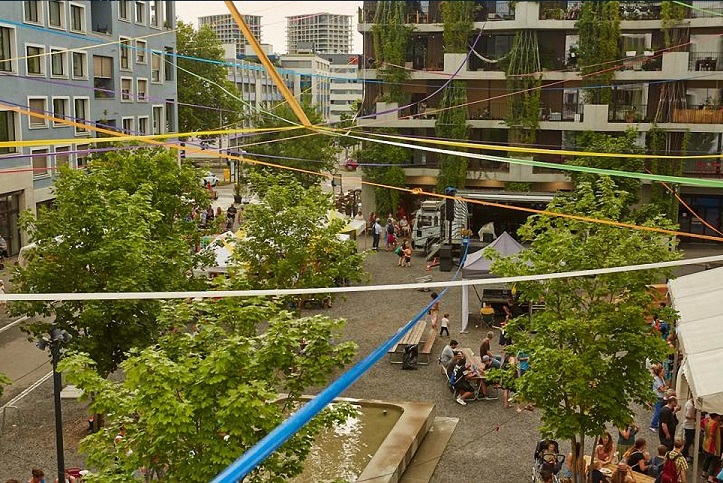 Annual 2000-watt neighborhood party in Zurich Oerlikon
Annual 2000-watt neighborhood party in Zurich Oerlikon
 Playground shared between a school and the 2000-watt neighborhood in Zurich Oerlikon
Playground shared between a school and the 2000-watt neighborhood in Zurich Oerlikon
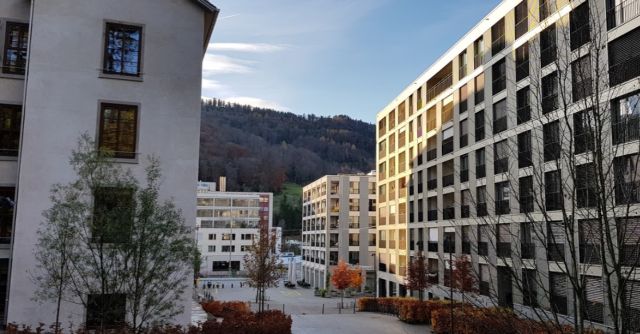 The 2000-watt neighborhood GreenCity in Zurich, between a highway and a railway, close to forests with many hiking trails. The old building on the left is a former textile factory, converted into apartments and lofts and renovated to the very low energy consumption standard called "Minergie-plus".
The 2000-watt neighborhood GreenCity in Zurich, between a highway and a railway, close to forests with many hiking trails. The old building on the left is a former textile factory, converted into apartments and lofts and renovated to the very low energy consumption standard called "Minergie-plus".
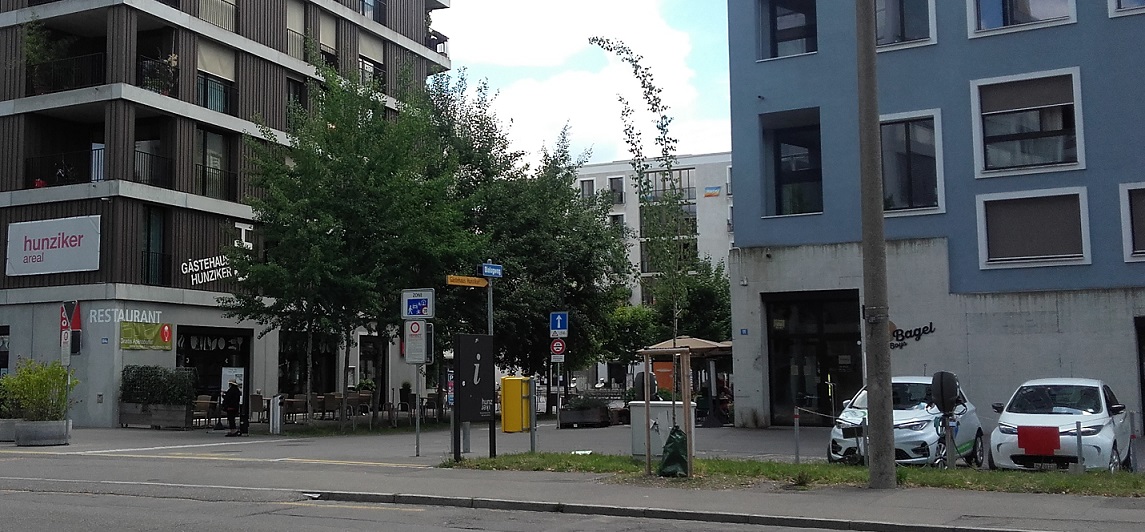 Parking with a charging station for electric cars belonging to the 2000 watt neighborhood in Zurich Oerlikon. These cars can be rented easily using the neighborhood specific mobile phone app. The same application is also used to monitor energy consumption of the apartment in real time, to make a reservation in one of the neighborhood restaurants, to reserve and rent a common room, etc.
Parking with a charging station for electric cars belonging to the 2000 watt neighborhood in Zurich Oerlikon. These cars can be rented easily using the neighborhood specific mobile phone app. The same application is also used to monitor energy consumption of the apartment in real time, to make a reservation in one of the neighborhood restaurants, to reserve and rent a common room, etc.
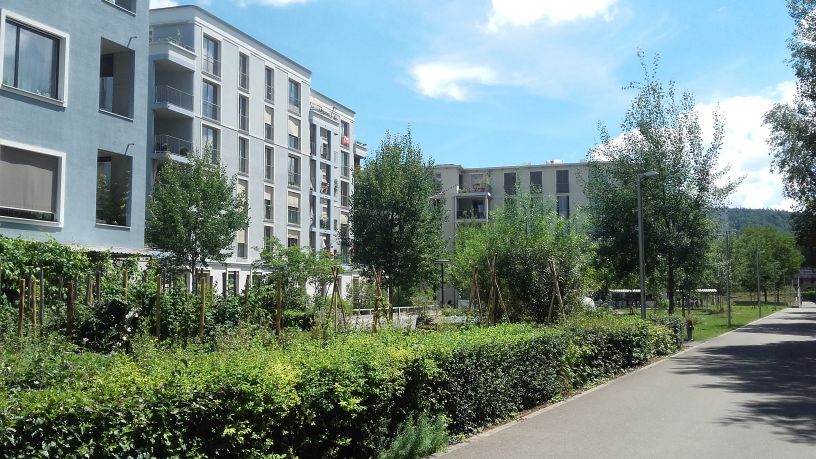 On the left: 2000-watt neighborhood in Zurich Oerlikon with a few square meters for biodiversity.
On the left: 2000-watt neighborhood in Zurich Oerlikon with a few square meters for biodiversity.
 Inner court of the 2000-watt-neighborhood called Kalkbreite. Eight tramways are stationed below this court.
Inner court of the 2000-watt-neighborhood called Kalkbreite. Eight tramways are stationed below this court.
The following co-ownership building is not part of a 2000-watt neighborhood, but its residents took the 2000-watt referendum vote seriously. They wrote their contract with the rest of the world on the facade of the building. The building is located at Badenerstrasse 380, 8004 Zürich. Here is the translation of the contract (German "Vertrag"):
This contract binds the inhabitants of this building to do whatever is needed to reduce their constant energy consumption to a maximum of 2000 watts. If this commitment is not respected, the rest of the world has the right to damages. Place of Jurisdiction: Zürich. Applicable law: Swiss law. Signed: the inhabitants of this building.
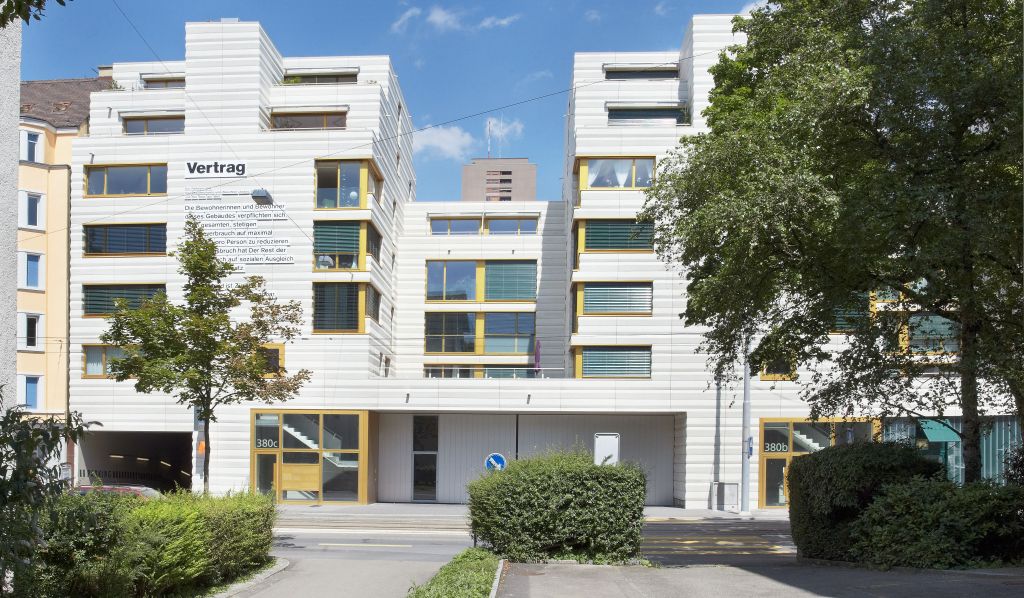
Footnotes
[1] ˄ IEA, World energy investment 2019, page 19: In 2018 in Europe, 140 billion were invested in the entire energy sector: production of fossil fuels, production of electricity with coal, gas, renewables and nuclear. In addition, 70 billion have been invested in improving energy efficiency, for example by improving building insulation. Europe would have to invest 400 billion per year for the next 30 years to replace a third of fossil fuels with renewables and thus create the energy sources for 2000-watt society. Current investments should therefore be multiplied by three. Since energy use in North America is about 40% higher than in Europe, investments for non-carbon energy sources would have to be higher too. Between a quarter and a third of fossil fuels can be saved by energy efficiency gains (e.g. better insulation of buildings) and more than a third must be saved by a reduction in individual wealth (reduction in GDP) if global warming is to be limited to 2°C.
[2] ˄ IEA, World energy investment 2019, RD&D and new technologies, 2019
[3] ˄ After completing the calculations, the astronomical numbers prompted the author to abandon 40 years of anti-nuclear activism. The goal of the book is therefore not to defend an ideal theory with literary eloquence, but to propose practical and feasible solutions. The book discusses different nuclear options. Because of the initial investment and the high long-term cost of nuclear power-stations, replacing all fossil fuels with nuclear power is not the solution to the problem of mankind's limited means on a limited planet.
[4] ˄ Total Consumer Power Consumption Forecast, Anders Andrae, page 20. It is assumed that Moore's law will come to an end by around 2025, as investments for new electronic circuit manufacturing plants has grown exponentially over the past 8 years. Investments for a new production line of 5nm structures already reach around 50 billion dollars in 2022 and probably only one or two companies in the world will be capable tp produce circuits using 5nm and 3nm structures. Thus, after 2025, the energy efficiency of data centers will probably increase much slower than the volume of data due to 5D phone technology, artificial intelligence and metaverses.
[5] ˄ All molecules composed of at least three atoms [H2O, CO2, CH4, N2O, ...) absorb the earth's long-wave radiation and therefore become warmer. They then radiate part of that absorbed heat back to the earth. This physical effect is called the greenhouse effect and produces global warming. Like all other oxides, CO2 molecules are extremely stable, which makes the process of global warming almost irreversible. Without any of these greenhouse gases, the earth would be 20°C colder and would have the average temperature of the moon.
[6] ˄ Examples: In 2020, according to real estate brokerage firm Redfin, in California alone, real estate worth $ 2000 billions is now in areas at risk of wildfires. Since the 2019 floods, in the Texas city of Houston alone, 220 000 homes are now in areas at risk of flooding. Consequences: In these areas, insurance premiums rise rapidly and house prices fall. These indirect losses are not included in the disaster cost calculations. Calculated for the whole world, the indirect and direct losses are already huge, and they will increase exponentially with each degree of global warming. In 2020 in the United States, direct losses due to fires and floods were $ 95 billion (TIME, 05/17/2021 p.67). The Global Commission on Adaptation (GCA) writes in its latest report that we must also invest to adapt to climate change, for example investing to make infrastructure more resilient, develop agriculture for dryer seasons and protect mangroves. $ 1 invested today will avoid losses of $ 7 in 2030.
The direct and indirect costs of climate change were calculated and estimated already in 2006 by Nicholas Stern, in his voluminous report "Review on the Economics on Climate Change", London School of Economics. The report is very well documented, ... and has been largely ignored. In a paper published in 2019, Nicholas Stern and Andrew Oswald from Warwick university made this observation: "Of the 77 000 articles published by the most renowned academic journals in economics, only 57 concerned the topic of climate change, i.e. a proportion of 0.074%".
[7] ˄ IEA, Sustainable Recovery Tracker, July 2021. Furthermore, demand for high-energy-coal used for electricity production is expected to rise considerably.
[8] ˄ Institute Othering & Belonging, university of Berkley California, Most to Least Segregated Cities. In 2019, 80% of cities with more than 200,000 inhabitants had more racial, ethnic, social and political segregation than in 1990. This segregation increases the polarization of society. Stephen Menendian, director of the institute, concludes: "This country is still in dire shape".
[9] ˄ Stanford Institute for Economic Policy Research, Cross-country trends in affective polarization, jan.2020. In 1978, on a scale of 0 to 100, Americans rated the difference in their feelings towards members of their own preferred political party compared to those towards of the other party at 27. On the same scale, if Americans learn which party a person is voting for, the difference of feeling increased to 56 in 2019. According to this paper, American political parties have become "conglomerates of identity tribes". Yet, in countries like Germany, Norway and Switzerland, affective polarization has declined since 2000.
[10] ˄ Psychology Today, Why Is Narcissism Increasing Among Young Americans?, Peter Gray, Jan 2014
Net-zero neighborhood pilot project
Motto: Optimum comfort with the smallest possible environmental footprint and energy consumption
As mentioned in the introduction to the German book "Energy Transition and Social Change", we are not pursuing a theoretical goal, but would like to put the findings of the book into practice.
Therefore, several households plan to set up a residents' cooperative or condominium that pursues the goals of the 2000-watt neighborhood as far as possible. It should be both environmentally friendly and have a very small CO2 and energy footprint. Hopefully, urban people will find the way of life attractive in order to spread the model around big cities.
One of the available plots of 10000 m² is between 10 and 15 minutes walk from a kindergarten, a primary school, a high school, a bakery, a pharmacy and a supermarket. The train station, the theater and a ballet-school can be reached by bike in 10 minutes. A bus stop is a 5-minute walk from the property.
One of the plots has space for several buildings, each with a 4 apartments or houses on 2 floors. The buildings must comply with the French RT2020 standard (heating lower than 15 kWh/m²/year). The private living space is below the French average, but the buildings should contain some common infrastructure: DIY workshop, sewing workshop, party room with kitchen, library, studios for visitors or Airbnb, terrace with pergola, park with playground, etc. The aim is optimal use of objects and infrastructure with a low ecological footprint, which also allows a good life for people with low income.
 Example of a common room with kitchen for meetings, family-gatherings and parties.
Example of a common room with kitchen for meetings, family-gatherings and parties. Example of a 3 or 4-family house with excellent thermal and noise insulation to guarantee privacy.
Example of a 3 or 4-family house with excellent thermal and noise insulation to guarantee privacy.
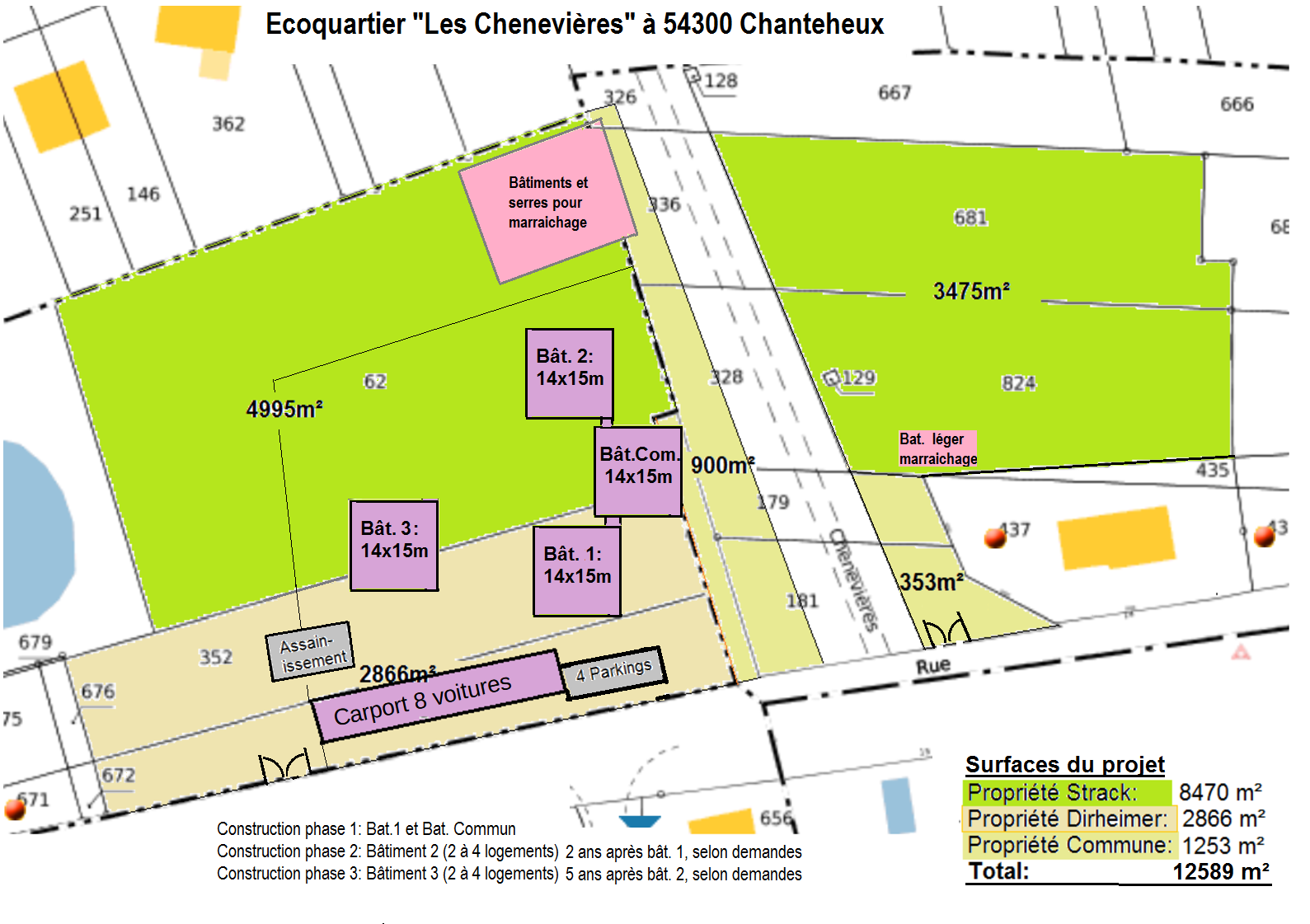 Plan with 4 buildings as accepted by the authorities. Building "Bât Com" contains shared rooms, such as a party room with kitchen, workshops and guest-rooms.
Plan with 4 buildings as accepted by the authorities. Building "Bât Com" contains shared rooms, such as a party room with kitchen, workshops and guest-rooms.
Four such buildings for 12 to 16 apartments will be connected by common infrastructures. The individual living space will be smaller than the French average, but the common infrastructures will give more comfort and options than French average.
Instead of concrete underground garages, a large wooden carport could be built, covered with photovoltaic panels. 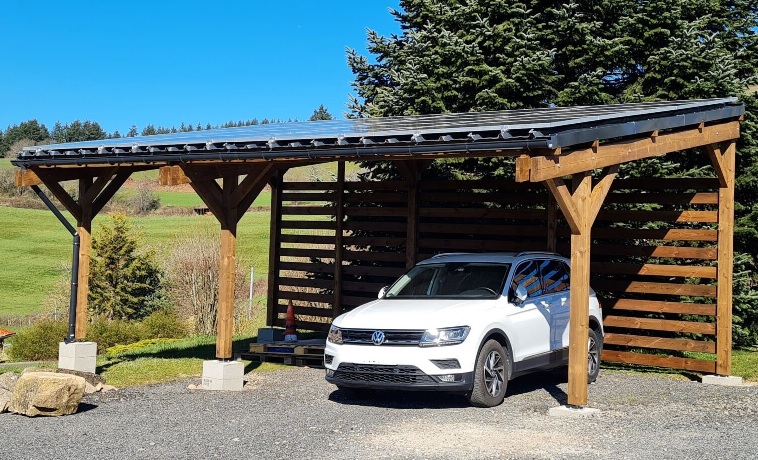 Some charging stations for electric cars could be installed under the carport.
Some charging stations for electric cars could be installed under the carport.
If a member of the housing cooperative or condominium wants to try gastronomy and all other members of the residents' cooperative agree, parts of the common infrastructure could be used as a restaurant from 1 time a month to 3 times a week. Some households of some housing cooperatives employ a cook 3 or 4 days a week to do the cooking of a meal for them. Common infrastructures allow different kind of experiments if everybody agrees.
A large part of the land is used for growing vegetables and fruits. The plots have a lot of groundwater for irrigation during dry summers. A well 4 m deep can supply at least 8 m3 of water per hour, even during dry and hot summers.
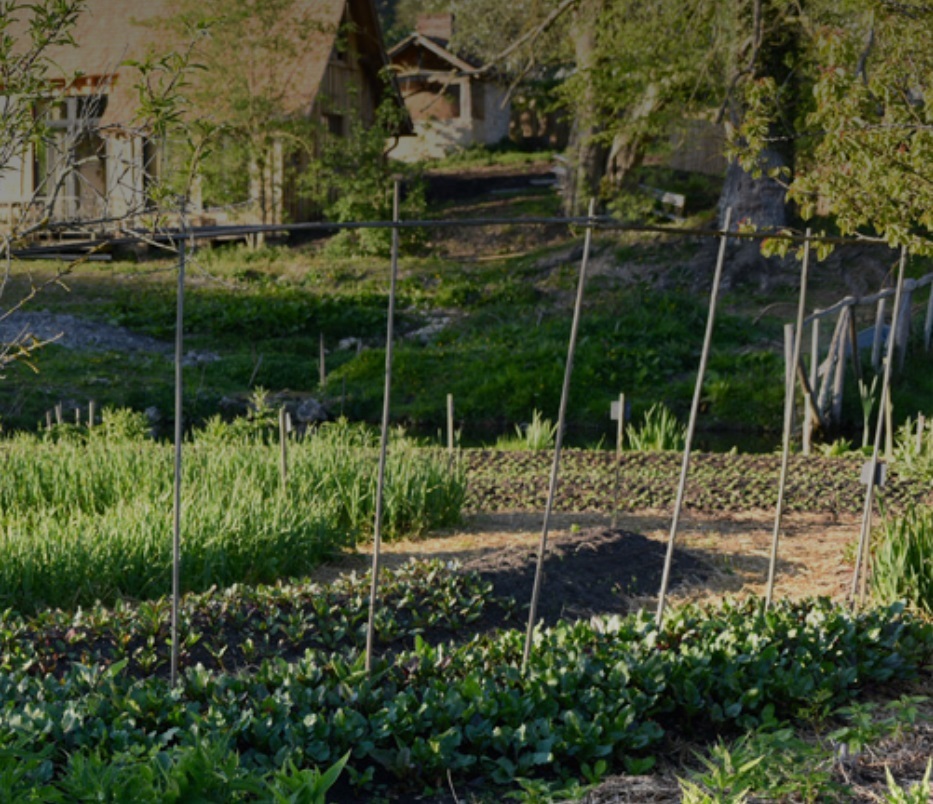 Micro farm "Bec Helloin" produces organic vegetables with high yield.The land for growing vegetables can either be bought privately, from a cooperative, or leased from the current owner. The residents' cooperative could offer the market gardeners a point of sale if they wished it. This project, like everything else, will be discussed and adjusted by the future members of the residents' cooperative and/or by the members of the gardeners cooperative.
Micro farm "Bec Helloin" produces organic vegetables with high yield.The land for growing vegetables can either be bought privately, from a cooperative, or leased from the current owner. The residents' cooperative could offer the market gardeners a point of sale if they wished it. This project, like everything else, will be discussed and adjusted by the future members of the residents' cooperative and/or by the members of the gardeners cooperative.
Since the energy consumption is roughly proportional to the money spent, the running costs should be as low as possible. Fiber subscriptions could be shared. Water management should be optimized as it reduces operating costs and saves a lot of drinking water. The city council has already given the go-ahead to set up an on-site wastewater treatment system that also recovers rainwater, as successfully implemented by a cooperative in Geneva. The system is "low tech" and was designed by the Swiss Federal Institute of Technology.
Another idea concerns water management, which could be optimized to reduce operating costs. We also want to create a wastewater sanitation and rainwater recovery system on site, as was created by a cooperative in Geneva (Equilibre; rue Soubeyran). The cooperative in Geneva recovers rainwater and organic matter from homes and toilettes, which is used in agriculture after a two-way composting. The farmer can thus reduce the use of chemical fertilizers or get rid of it altogether. The manufacture of nitrogen fertilizers for industrial agriculture consumes too much energy (natural gas). The sanitation system also makes it possible to divide residents' water bills by two or three. Our Municipality has also expressed an interest in this sanitation system. The system is low-tech even though it was designed by the Swiss Federal Institute of Technology of Lausanne. The system has no pumps.
Theoretical carbon footprint of the project
Out of pure curiosity and without any obligation for the future project, the CO₂ footprint of the way of life in such a neighborhood was simulated on the French ADEME website. The website does not allow simulating reduced water use and production of toilette compost. The most important parameter for the choice of an electric car would be the number of charge/discharge cycles. With 10'000 cycles and 200 km per cycle, the car could drive 2 million km and have a theoretical lifespan of a century, if everything fits perfectly together. The ADEME website cannot simulate that either. Otherwise, we made the following assumptions for the carbon footprint simulation :
- Mobility: 1 Small electric car per household. Each inhabitant travels an average of 5000 km per year with a car. If one inhabitant drives 1000 km only, another may drive 9000 km per year. During the day, the cars are recharged via the neighborhood's solar panels to avoid losses due to the storage of electricity in a far away water pump power station for charging during the night. Train journeys: 2000 km per year per person. One electric bike per person, driving 800 km per year.
- Diet: Seasonal and local cuisine with little meat. Some of the food is produced and the land of the cooperative by professional gardeners.
- General consumption: Very little waste is produced and only few new equipments are purchased, since most of the expensive equipments with a long lifespan belong to the housing cooperative or condominium. Composting of organic waste for the vegetable gardeners.
Simulation result: 1.9 tons of CO₂ per year and per person. That does not include French state services (1.6 tons of CO₂ per year). Such a way of life can therefore be considered sustainable, provided that the government and the industries also makes some efforts. In addition, the energy mix of countries exporting products to France must further decarbonize their economies in order to achieve 2 t CO₂ per year.
Comparison: Pilot project : 3.5 t of CO2 per year, including 1.6 t for the state (ADEME).
The "average" French citizen emits 9 t of CO2 per year (INSEE), the "average" German 11 t, the American 15 t, a Chinese 7 t, an African outside South Africa 1.5 tons of CO2 (statistica).
Since the carbon footprint and energy consumption correlate with living costs, the project is also open for people with a lower income.
We will begin to work out the detailed specifications of this project as soon as 8 households have expressed their interest. We are therefore looking for people interested in such a residents' cooperative or condominium. Curious or interested people can contact us via the contact menu of this website. We usually reply within a day.
The project will be carried out in two or three stages, depending on the number of people participating from the start.
Photos of the available building land of 12'000 m²

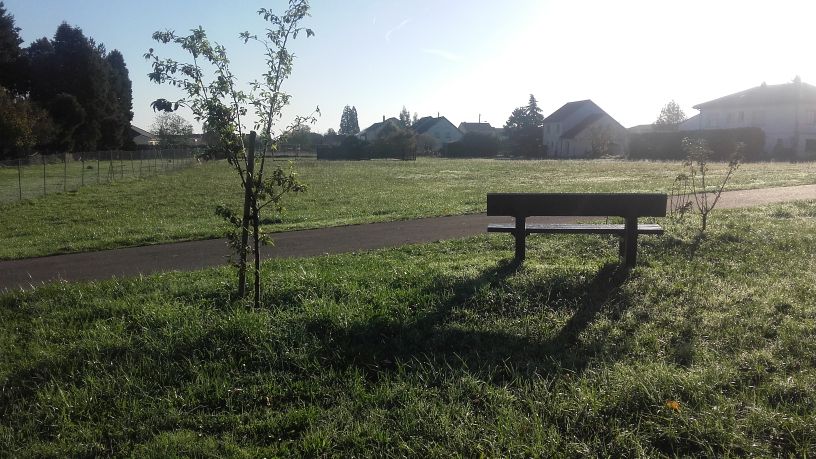

Practically sustainable 2000-watt-neighborhoods
Table of content
- Foreword of our MP and Maire
-
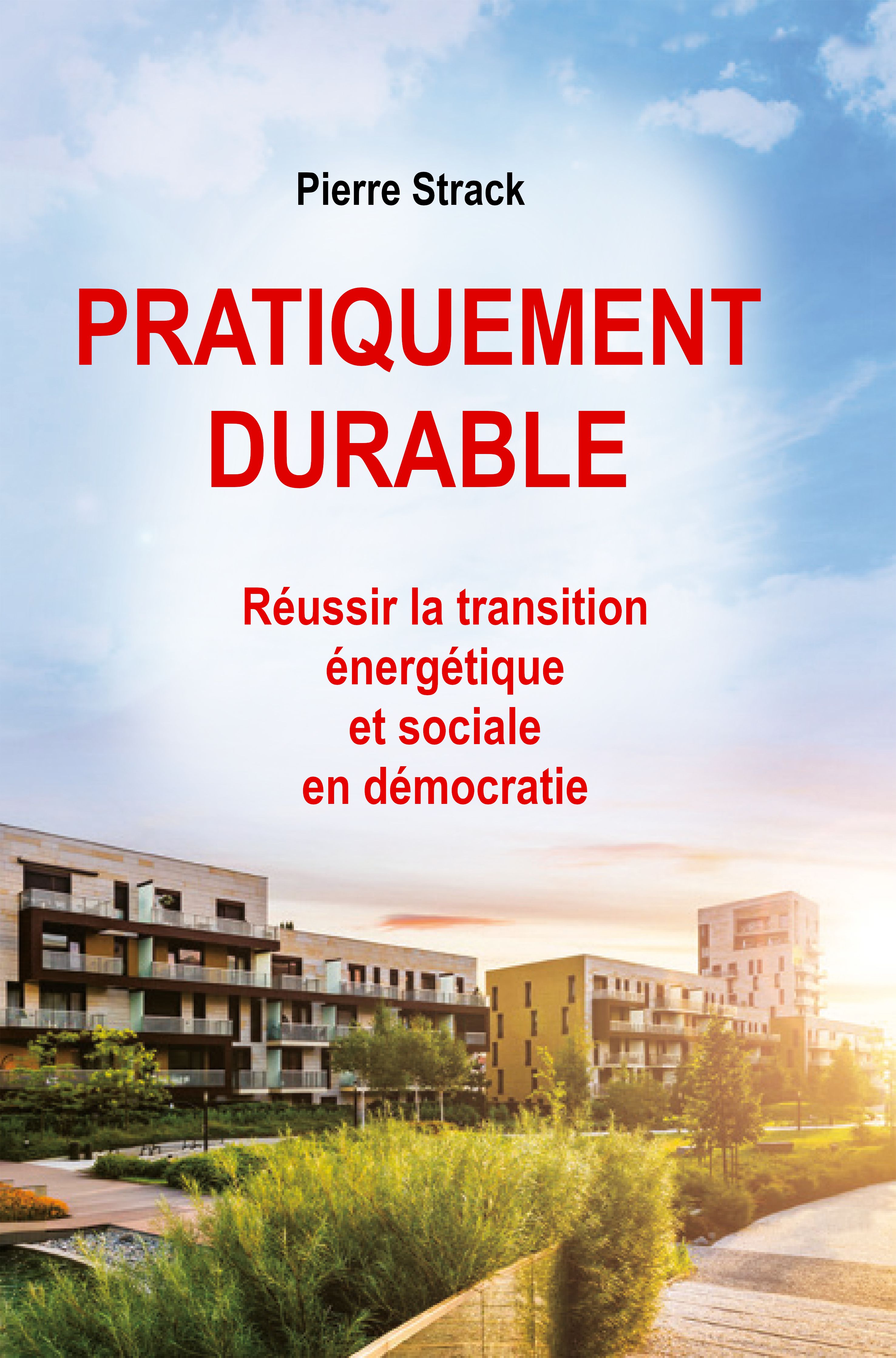 The revised new edition of this french book is available only with Amazon.
The revised new edition of this french book is available only with Amazon. - 1. Introduction
PART I: TECHNICAL PROBLEMS
- 2. Limits of the industrial civilization
- 2.1 Replacing fossil fuels with renewable energies
- 2.2 Relationship between global growth and global energy consumption
- 2.3 Nuclear Energy
- 2.4 Political commitments and reality
- 2.5 Funding, risks and opportunities
- 3. Physical limits of "green growth"
- 3.1 Accepting and living with our planetary limits
PART II: TECHNICAL SOLUTIONS
- 4. 2000-watt neighborhoods
- 4.1 Pursued goals of 2000-watts-neighborhoods
- 4.2 Planning a neighborhood
- 4.3 Social organization of a 2000-watt-neighborhood
- 4.4 Neighborhoods during an epidemic
- 4.5 Implemented techniques
- 4.6 Example of the neighborhood called Kalkbreite
- 4.7 Finances
- 4.8 Theoretical status of 2000-watt-neighborhood in France
- 4.9 Certifications of a 2000-watt-neighborhood
- 4.10 Conclusion about the feasibility
- 5. Sustainable agriculture for post-oil-society
- 5.1 The matrix of urban civilization
- 5.2 The character of Empire
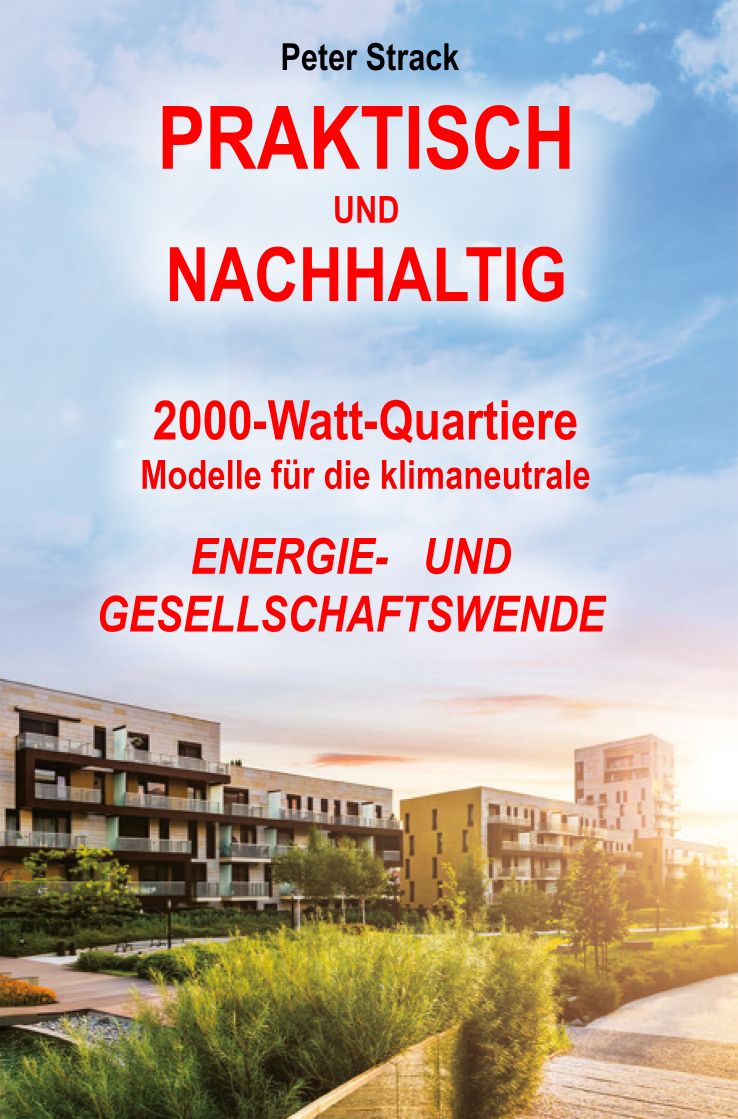 The german book is available in bookshops and in the internet.
The german book is available in bookshops and in the internet. - 5.3 The productivist agricultural policy of empires
- 5.4 Sustainable agriculture
- 5.5 Contribution of city dwellers to the transformation of agriculture
PART III: HUMAN DIFFICULTIES AND POTENTIALS
- 6. Limits of the materialistic philosophy
- 6.1 Premises of the dominant philosophy
- 7. Freedom for the 2000-watt post-oil-society
- 7.1 Freedom of machinery
- 7.2 Freedom of thought
- 7.3 Freedom of the powerful
- 7.4 Negative freedom
- 7.5 Positive freedom
- 7.6 Sustainable freedom?
- 8. Equality of 2000-watt
- 8.1 Cultural notions of equality
- 8.2 Complex equality allowing diversity
- 8.3 Simple equality of clones
- 8.4 Identities
- 8.5 Equality of energy consumption
- 8.6 Historical development of the concept of Justice
- 9. A sense of community for the post-oil society
- 9.1 Destructive models of Fraternity
- 9.2 Fraternity through semi-direct democracy
- 9.3 Cooperative fraternity
- 9.4 Restorative justice
- 9.5 Fraternity with Creation
- 9.6 Conclusion
- 10. Limiting the power of money over the human mind
- 10.1 Mammon’s Insatiability
- 10.2 Three notions of ownership
- 10.3 When are we satisfied with our wealth?
- 11. Reducing the number of machine-slaves at our service
- 11.1 Very brief history of slavery
- 11.2 Struggles against slavery
- 11.3 Conclusion on machine-slaves
- 12. Conclusion
1. Introduction
Many professionals do important work in countless fields; they multiply very useful knowledge for humanity. This knowledge allows us to create ever more complex societies, at the risk of losing sight of the links between these fields of knowledge. Experts select and write volumes on ever more specialized subjects. In other words, specialists always write more about less. This absurd tendency would lead the best specialists to soon know almost everything about next to nothing.
The downside of specializing in ever narrower disciplines is that the big picture of human society fades away. Often, specialists no longer have a global vision of their own field of competence, let alone of different fields. For this reason, universities see a growing need to create interdisciplinary laboratories, such as the Transdisciplinary Lab at the Swiss Federal Institute of Technology, whose contributions to the 2000-watt neighborhoods will be discussed in this book. Bringing together experts from different disciplines is not easy, as each field uses its own language, which may seem hermetic to the uninitiated.
In the midst of the Covid-19 crisis, Edgar Morin, a French philosopher, said: "How do we have to confront, select and organize all our knowledge adequately by bringing all our knowledge together and integrating uncertainty ? For me, this once again reveals the deficiency of the way we have been taught to acquire knowledge, which makes us disjoint what is inseparable and reduce to a single element what forms a whole, both one and diverse. Indeed, the overwhelming revelation of the upheavals we are undergoing is that whatever seemed separate is connected, since a health crisis extends its catastrophe to all that is human" [1].
Without a general overview, we no longer know how to find our way. Indeed, while some give priority to ecological and climatic problems and accept a reduction of economic output, others see unemployment and poverty and ask for more GDP growth. Some say we need to save energy by creating smaller cars, others say we need to make high-end vehicles which are more profitable, since SUVs sell more easily and generate more profits for the businesses. Some want to reduce car traffic while others increasingly depend on it; which led to the yellow vests revolt in France and accentuated the opposition between large urban centers and rural communities — an opposition dating back 5000 years — which will be developed in Chapter 5.
No wonder, then, that many philosophers and artists find human life absurd and meaningless. Jean Viard, a French sociologist, said on a news channel on January 16, 2020: "Pessimism feeds mainly on the lack of perspective, the French do not know where they are going". "Without vision the people go haywire" said a king of the ancient Hebrews according to the translation of Chouraqui. Not identified sources of anxieties and a lack of perspective risk pushing our societies to political extremes that nobody really wants. "What blocks us is that we do not know what a pleasant life in a carbon-free society looks like" said Anne-Lorène Vernay, professor at Grenoble School of Management [2]. The 2000-watt neighborhoods show how a carbon-free society could look like, and they also give a vision to the rest of society of a pleasant way of life.
Rather than writing several books, each in a particular specialized area, in which the reader will not see the dependencies between the subjects, I have chosen to develop in a single book the subjects that determine the transition to post-oil society, a "2000-watt society". My approach is not that of a researcher who, faced with a new phenomenon, seeks a new theory, but that of an engineer facing a great challenge, who seeks practical solutions to various problems, solutions that are technical, sociological and human.
The main thesis of the book is that civil society must initiate change since states and governments have decided for the last 30 years to reduce CO2 emissions but humanity as a whole actually doubled them. For more than 10 years, through the 2000-watt neighborhoods, parts of Swiss civil society have shown concrete solutions that many people would like to imitate. These neighborhoods also show that without a change in the priorities of the inhabitants, it is not possible to make a successful transition to the carbon neutral 2000-watt society. Without changing priorities and values, our societies will continue on the path of the past 30 years: announcing reductions in CO2 emissions and practicing the opposite, as long as fossil fuels are competitive. A critical analysis of the dominant values of our globalized societies therefore seems essential, because the dominant values influence the direction a society will take on the way to the post-oil society.
During the past 15 years, Sudan and Syria have experienced droughts, which have increased tensions in both countries. These tensions led to the outbreak of two extremely deadly and destructive civil wars. However, the consequences of these droughts could have been met with increased solidarity within each of these countries and with the help of other countries. Instead, they caused civil wars that made everything worse.
The hatred between Sunnis and Shiites, as expressed in Syria, dates back to the second inter-Islamic civil war, during which the clan of the fourth Caliph Ali (ancestor of Shia) was killed in the year 680, followed by the third civil war which ended with the extermination of the Umayyad clan (ancestors of the Sunnis) by the Abbasids between 744 and 750. Such hatred, maintained and nurtured for centuries, was an obstacle to the solidarity needed to overcome crises such as severe drought.
In Sudan, the central power despised the tribes of Darfur instead of relieving their suffering due to the drought, thus providing popular support for the rebels. In order to succeed the transition to a post-oil society, we need to think about the dominant values of a society, values that facilitate or complicate this transition.
Depending on the dominant values of a society, a crisis can engender active solidarity or trigger a civil war, if that society is made up of groups that hate each other and if this hatred is nourished by the power in place. Faced with severe problems, the governing group clinches to its power, because it knows that by losing it, ... Vae Victis! ... woe to the vanquished!
Segregated identity groups tend to consider their fellow citizens as strangers to be avoided, or even as enemies. Segregation is a source of opposition while an openness to the history of the culture of the other, with its qualities and weaknesses, helps to reduce segregation and the potential for conflict.
For these reasons I try to give a little historical depth to each subject, not to judge or condemn the past, but in order to illuminate the present.
Our material riches are produced by machines and automated factories that need a lot of energy. Global economic output is largely linked to energy consumption. But 80% of the global energies are of fossil origin. Chapter 2 will show why all fossil fuels cannot be replaced by renewable or low-carbon energies in less than 30 years, the cost is simply too high. Therefore, there is urgent need to seek new ways of life to maintain a good quality of life with lower energy consumption. Our resources are becoming scarce, likely making the transition to a post-oil society confrontational. Even before reaching the limits of our system, the tensions in our societies are already high: hatred and resentment increase in the struggle to capture "each one his due". A vision for a post-oil society must therefore also include reflections on the source and management of conflicts, often resolved by the courts. The courts are already overloaded with procedures and hearings, and they often do not contribute to a more peaceful society. There is, however, a form of justice that contributes to reconciliation rather than increasing tensions and culture wars. It could play a significant role in the successful transition to post-oil society and its many conflicts that need to be handled peacefully (details in chapter 9).
Thanks to the creation of eco-neighborhoods which benefit from the latest technologies of low-energy buildings, investors and institutions can make an important contribution to reducing energy consumption. These institutions can thus lead to a society of about 3 500 watts in countries like Great Britain and then, through the choices of the inhabitants of these eco-neighborhoods, they can advance towards a carbon free 2000-watt-society (details in Chapter 5).
But in our individualistic and mass-consumer societies, increasing purchasing power is dogma: no presidential candidate in any country would be elected if he promises a slow decline of purchasing power over the next 30 years. However, in order to evolve towards a post-oil society, a decrease in individual purchasing power will occur either willingly or by natural forces, generating a movement of solidarity or conflict, without loss of quality of life or with loss, with 2°C or more than 4°C of global warming.
If we want to succeed in building a post-oil society democratically, peacefully, without losing quality of life, but by reducing individual purchasing power, a reflection on the nature of money and its influence on the human mind seems necessary (details in chapter 10). The 2000-watt neighborhoods are also experimenting promising strategies.
The International Energy Agency (IEA) never tires of emphasizing that a large part of the energy savings must come about through changes in the behavior of the population. Therefore, in order to maintain a good quality of life, we need to reflect on the values and priorities that guide our choices as consumers that allow us to reduce energy consumption to a level considered to be sustainable. This reflection is obviously expressed under the influence of my cultural background, and it is to be hoped that everyone will find in their own cultural roots values and priorities compatible with a 2000-watt society.
This is why this book analyzes the dominant philosophy of our society and develops the sociological, philosophical, and practical aspects of a functioning 2000-watt society. The book, therefore, contains many practical proposals, carried out in several 2000-watt neighborhoods or eco-communities. Thus, another principle guides this book: in a reasonable democratic society, a criticism carries no more weight than the counter-proposal that responds to the subject criticized. My social and economic criticism is therefore accompanied by proposals in all the fields that are analyzed.
These days, bad news about ecology, biodiversity and climate change are piling up, creating a heavy atmosphere of an uncertain future. Books and conferences with distressing and paralyzing perspectives on the collapse of our industrial civilization are multiplying, such as "The long emergency" of J.H. Kunstler or the last book by Yves Cochet, former French Minister of Ecology, which proposes "solutions" after the disappearance of a great part of humanity due to wars and climate disasters. One of his tips is to organize resilient neighbors with a sustainable lifestyle, which resembles the spirit of 2000-watt neighborhoods.
The announced catastrophes are in the more or less distant future; but the consequences of our present actions are not strongly visible yet. Never in the past has humanity had to make drastic decisions without seeing clearly the consequences of its actions. However, to avoid the announced climatic and social catastrophes, we would have to change our economy and our lifestyles now. If we wait until the climatic, economic, and social consequences are visible enough, it will be too late to maintain a comfortable life in peace. The good news is that the 2000-watt communities provide concrete answers to this human dilemma. I will try to demonstrate that under certain conditions, the 2000-watt society, of which the 2000-watt neighborhoods are the fields of experimentation, allows us to live comfortably in an ecologically and economically sustainable way. But before presenting the solution through the 2000-watt neighborhoods, we must examine the problems they try to solve. (A few problems are described in the HOME menu of this web-site).
Some of the problems may seem insurmountable. However, I share the optimism of Winston Churchill who participated in the greatest triumph of the twentieth century by fighting the indescribable brutality of the Third Reich: "Success consists of going from failure to failure without loss of enthusiasm".
Readers with little time to spare can follow the texts in bold characters which summarize the conclusion of each point of argument. If the reader finds the conclusion surprising, he can then read the preceding paragraphs in order to find an explanation.
Chapter 2 may be too technical for some. They too may just follow the bold characters in order to understand the basics of our industrial civilisation.
2. Limits of the industrial civilisation
(See home-page for a summary of some limits of the industrial civilisation)
Correlating quality of life with energy consumption was first studied in Brazil. In 1985, the Brazilian scientist José Goldemberg asked himself how much energy is needed to lead a decent life. He found that below a threshold of 1000 watts per person, people improve their life if they can increase their energy consumption [3]. As soon as this threshold of 1000 watts is reached, however, increasing energy consumption no longer improves the quality of life and the well-being of the population no longer increases. He made the observations and calculations based on the Brazilian climate. In order to be able to lead a decent life, the minimum amount of energy is, of course, higher in countries with lower average temperatures.
After 1995, a number of researchers at the Swiss Federal Institute of Technology took up Goldemberg's idea again. In order to adapt it to the local conditions, the energy consumption per capita was set at 2000 instead of 1000 watts, which also corresponded to the world average of 1995. Originally, the gray energy [4] needed to build and maintain public infrastructures and services was not included in the 2000 watts. The researchers' calculations showed that the 2000 watts would allow us to maintain our current standard of living, albeit with some social and economic adjustments. If the energy mix is changed in favor of renewable energies, this energy consumption is also sustainable.
Regardless of whether we look at the question of energy in the post-oil society from the perspective of limited financial resources, or are looking for the minimum needed for a comfortable life, or tackle the question of a fair global distribution of limited resources, the result always leads to an energy consumption of around 2000 watts per person, at least for countries with a Central European moderate climate.
Defining an amount of energy to determine the human impact on the environment has an advantage over other definitions, such as the "ecological ceiling" proposed by the Donut Economics Action Lab. The notion of "ecological ceiling" is certainly useful for policy discussions and decisions, but is too complex to orientate people's everyday decisions. The limit of 2000 watts per capita is quantifiable, measurable and understandable for the majority of the population. Every household and every neighborhood can regularly check its energy-consumption and see the progress on the way to a clearly defined goal. The definition of 2000 watts is useful to motivate residents to work together to reach a common goal.
 Increase in GDP: eight different packages for a piece of chocolate. The 8th packaging is the foil around the cardboard box.In the following, a distinction must be made between the 2000-watt society and the 2000-watt neighborhood. The 2000-watt neighborhoods are models and places of experimentation that are intended to show society as a whole the way into the post-oil society. If Europe really wants to reach carbon-neutrality by 2050 and thus achieve the goal of the 2000 watt society, then Europe could become a model for the rest of the planet. Europe has been a model for the production of wealth for the rest of the planet for the last two centuries. Unfortunately, this model is too destructive and unsustainable for the planet. At this turning point in human history, Europe could decide to become some sort of sustainable 2000-watt-society. Humanity is lacking in positive role models, and Europe could fill that void. Above all, Europeans should not make an inferiority complex if during this process the European gross domestic product (GDP) falls compared to China or the United States. In the post-oil-society, progress consists in ensuring a good quality of life with greatly reduced energy requirements. The mere increase in the gross national product destroys our future and is not a symbol of greatness.
Increase in GDP: eight different packages for a piece of chocolate. The 8th packaging is the foil around the cardboard box.In the following, a distinction must be made between the 2000-watt society and the 2000-watt neighborhood. The 2000-watt neighborhoods are models and places of experimentation that are intended to show society as a whole the way into the post-oil society. If Europe really wants to reach carbon-neutrality by 2050 and thus achieve the goal of the 2000 watt society, then Europe could become a model for the rest of the planet. Europe has been a model for the production of wealth for the rest of the planet for the last two centuries. Unfortunately, this model is too destructive and unsustainable for the planet. At this turning point in human history, Europe could decide to become some sort of sustainable 2000-watt-society. Humanity is lacking in positive role models, and Europe could fill that void. Above all, Europeans should not make an inferiority complex if during this process the European gross domestic product (GDP) falls compared to China or the United States. In the post-oil-society, progress consists in ensuring a good quality of life with greatly reduced energy requirements. The mere increase in the gross national product destroys our future and is not a symbol of greatness.
The gross domestic product also rises in a society in which ever heavier cars move in ever longer traffic jams, more food is thrown away, the life-cycle of electronic devices becomes shorter, the volume of packaging increases, more expensive drugs are consumed even by healthy people, unnecessary surgical operations are performed [5], the number of single person households increases needing more housing, citizens are more often appealing to justice even for minor issues, fashionable people make vacations at the other side of the planet and the primeval forests are being cut down in order to grow soybeans for our industrial breeding farms. These are not signs of the greatness of a culture, but of its decline that may well end with a collaps.
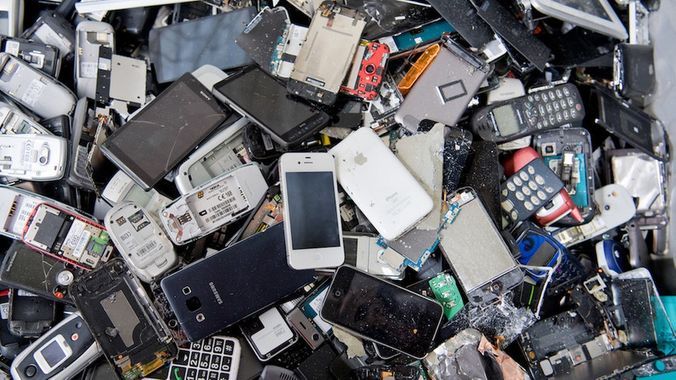 Photo: These electronic devices have increased the gross domestic product, above all if their life-cycle was short.
Photo: These electronic devices have increased the gross domestic product, above all if their life-cycle was short.
 Photo: Primeval rain forest in Brazil. A carbon tax of $200 per ton of captured CO2 would make these forests just as valuable for the computation of the GDP as soybean fields. To make fossil energy artificially more expensive, we would need a carbon tax of € 200 per ton of CO2 and redistribute the revenues from this tax in the form of subsidies. The subsidies could be used to better insulate buildings, or help the steel-industry to manufacture steel with hydrogen rather than using coal.To economists and the current financial system, pristine rainforests are of no value. These primeval forests are not included in the calculations of the gross domestic product (GDP), they are ignored by the statistical institutes. Yet, these forests are the "lungs of the earth", they bind a lot of CO2 and play an important role in the climate. According to the "World Resources Institute" (WRI), the jungle of the Republic of the Congo binds 600 million tons of CO2 per year. But these type of forests do not count for a country's GDP. It should therefore not surprise anyone that these forests are treated as if they were worth nothing.
Photo: Primeval rain forest in Brazil. A carbon tax of $200 per ton of captured CO2 would make these forests just as valuable for the computation of the GDP as soybean fields. To make fossil energy artificially more expensive, we would need a carbon tax of € 200 per ton of CO2 and redistribute the revenues from this tax in the form of subsidies. The subsidies could be used to better insulate buildings, or help the steel-industry to manufacture steel with hydrogen rather than using coal.To economists and the current financial system, pristine rainforests are of no value. These primeval forests are not included in the calculations of the gross domestic product (GDP), they are ignored by the statistical institutes. Yet, these forests are the "lungs of the earth", they bind a lot of CO2 and play an important role in the climate. According to the "World Resources Institute" (WRI), the jungle of the Republic of the Congo binds 600 million tons of CO2 per year. But these type of forests do not count for a country's GDP. It should therefore not surprise anyone that these forests are treated as if they were worth nothing.
According to the WRI, due to the forest fires of the last 5 years, the Amazon region emits the same amount of CO2 as its primeval forests bind. For this reason, the Amazon region as a whole no longer works as a carbon-sink. We therefore urgently need a corruption-resistant international market for carbon-sinks in order to appreciate these forests for their real value.
 But a country's GDP increases when it cuts down trees in a primeval forest, burns the undergrowth and then turns the land into soybean fields.
But a country's GDP increases when it cuts down trees in a primeval forest, burns the undergrowth and then turns the land into soybean fields.
The International Energy Agency (IEA) writes in its report "Net Zero by 2050" that changes in human behavior should contribute as much to reducing CO2 emissions as energy efficiency gains in industry, transport and buildings combined. Two thirds of CO2 emission reductions cannot be achieved without the active participation of citizens [6]. The IEA report shows that it is not possible to always request a little more money, housing space, cars, exotic vacations, electronic devices and at the same time claim to achieve net-zero emissions in 2050. The IEA, therefore, confirms in 2021 the idea of the Swiss Federal Institute of Technology, which created the concept of the 2000-watt neighborhoods: The behavior of the citizens is absolutely crucial. But to change behavior, citizens need practical examples, accompanied by political and philosophical encouragements. This chapter shows practical examples of a lifestyle that is compatible with net-zero emissions, a lifestyle visible in 2000-watt neighborhoods. However, without understanding why people always want to consume more, it is difficult to see how one can achieve climate neutrality in a democracy during the next 30 years. Chapter 10 shows an anthropological aspect of the apparently insatiable human desires and how this human tendency can be mitigated.
[...] Achieving the goals of the 2000-watt neighborhoods requires thorough planning from the outset, taking into account many parameters. In all areas, quality takes precedence over quantity, according to a phrase from Saint-Exupéry. "Perfection is not achieved when there is nothing left to add, but when nothing can be removed [to ensure a certain function]".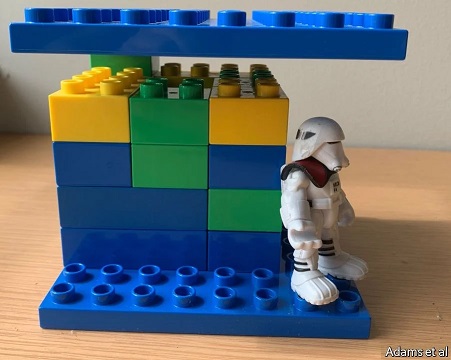
A study by Gabrielle Adams published in Nature shows that 80% of people prefer to add something to solve a problem rather than remove a component, function, phrase or idea. Eight different experiments have shown that participants will not see beneficial subtractive changes on their own unless instructed to think about simplification. This human tendency to seek additive change may be one of the reasons people struggle to cut back on their crowded schedules, simplify bureaucracy, and lessen the harmful effects of their behavior on the planet.
[...]
Institutional or private investors or residents' cooperatives can create buildings and infrastructure similar to those of the Eco- or 2000-watt neighborhoods and thus reduce energy consumption down to about 3500 watts per capita. But to evolve from around 3500 watts of permanent average consumption to 2000 watts, the means of a democratic government are limited. The behavioral changes of the inhabitants will have to produce the evolution to 2000 watts by changing priorities and values. Such freely chosen behavioral changes can be considered "creative ecology". State sponsored punitive ecology will not bring about the sustainable way of life that a 2000 watt society has to invent, revolts and chaos are a the more likely outcome.
Choosing to live in an eco-neighborhood while regularly changing the cell phone in order to be fashionable is not compatible with the 2000-watt society. Let us remember that producing a mobile phone consumes 250 kWh, i.e. a hundred times more than its use for 2 years. Offering yourself a good meal in one of the neighborhood restaurants or watching a movie in the small neighborhood cinema does not increase energy consumption. Watching a movie on high definition TV in streaming, everybody in its home, consumes much more power than watching the same movie together in the neighborhood cinema. Life in the 2000-watt society isn't bleak, it's just a little less flashy, less lonely and more human.
5.4. 2000-watt neighborhoods during an epidemic
Since 2000-watt neighborhoods have a fairly lively social life, facilitating sharing and meetings, the objection has been made that these neighborhoods are not compatible with an increase in epidemic risks expected during the twenty-first century. Since the start of the Covid-19 epidemic, this objection has been made regularly when we talk about these neighborhoods. However, after hearing several broadcasts from renowned virologist Christian Drosten of the Charité Hospital in Berlin, we came rather to the opposite conclusion. Professor Drosten explained, among other things, a study on the spread of an epidemic among desert runners in Kazakhstan [7]. The study tested an epidemiological model with actual infections, namely Yersinia pestis, the agent of plague. The researchers studied an effect that reflects the phenomenon of percolation [8].
The runner mice studied live in family groups in tunnel systems ranging in size from twenty to thirty meters in diameter. They don't dig any farther, the family groups that live there don't need more space. Sightings have been made up to four kilometers around an epidemic center. In the center is a family group in which the pathogen of plague was observed. Then the researchers observed family groups further and further away for the plague-center. If this disease spread strictly according to the reproductive concept of the "R" factor, then after a certain delay, each increase in population density in an observation area will lead to more infections everywhere.
But in reality, the increase in infections can only be seen nearby. Testing the animals a mile around the initially infected group still shows infections. But three kilometers from the central infected family group, a different observation is made. First, animal densities increase in groups seen around the original group without infections occurring in groups three kilometers away. Although the density of animals and the number of infections continue to increase up to one kilometer from the epidemic center, for a long time, no infection is seen within two or three kilometers. But suddenly, we find infections at a greater distance from the initial herd. The number of infected animals first had to exceed a threshold before it could spread to a larger distance. And how to explain this threshold effect? Family groups have only limited contact with each other. Sometimes an animal goes to a neighboring family. But essentially, these animals are isolated. For an infection to jump from family to family to family, a greater density of infected animals is needed. But if instead of two jumps of infections there need to be twenty, then only a very large infectious mass in the initial group can infect a family at a greater distance, no matter how long the observation lasts.
The two epidemics, the plague with running mice and Covid-19, have this in common that they spread strongly between foci of contamination. There are of course individual chains of transmission, but these chains sometimes break. Covid-19 is transmitted about two days before and five days after symptoms appear. In this window of time, the disease spreads if enough human encounters occur. One can imagine that infections develop in one place and are detected. Then the infections no longer spread from there, because the connectivity of this hotbed of contamination with other people is not great enough. However, if several chains of individual transmissions link different foci, then the contaminations spread rapidly. In other words, contaminations spread rapidly when the number of transmission chains has reached a certain threshold. It is therefore necessary to know this threshold effect in order not to feel falsely safe and become complacent. A false impression of an epidemic under control can suddenly spiral out of control and require drastic measures such as general containment. The acceleration of the increase in the number of Covid-19 contaminations in October 2020 in France, despite the protective measures still in place, surprised specialists according to their own statements. This acceleration could be explained by a threshold effect. In an individualistic society, the networks of relationships and contacts between humans are obviously too complex to integrate them precisely into an epidemiological model. But even if the calculations of the threshold remain very approximate, the existence of a threshold effect in the speed of the epidemic spread is real. Like Christian Drosten, the French epidemiologist Martin Blachier has repeatedly insisted on this threshold effect, unfortunately without having the media time necessary to make himself understood.
From an epidemiological standpoint, 2000 watt neighborhoods could be compared to a family group of running mice. In the event of an epidemic, neighborhoods could considerably reduce their relations with the rest of society without having to confine themselves individually. In 2020, many residents were still working outside these neighborhoods, but when the distances between workplaces and homes shrink as the post-oil era approaches, the majority of residents will likely work in the neighborhood. Since these neighborhoods offer many jobs, few people will be forced to go and work outside. The neighborhoods have shops, cinemas, restaurants, a hairdresser, doctors or a health center, a nursery and often a school. In case of an epidemic, residents can therefore have a more or less normal social life while considerably reducing contact with people outside the neighborhood. Since nurseries and schools remain open, teleworking is facilitated. Since 2000-watt neighborhoods often have studios to rent to visitors or a hotel, neighborhoods also have the means to isolate within the neighborhood the rare cases of contact or infected people. Isolating someone in their own neighborhood is humanly easier than isolating them in a hotel far from home.
If a society is structured by neighborhoods capable of operating more or less autonomously in case of an epidemic, it should not see contaminations exceed the critical threshold which causes the number of contaminations to explode. Epidemics should therefore remain under control without needing state-wide containments. Since each neighborhood is also able to "test, trace and isolate" the small number of people in contact with the outside, an epidemic will not be able to spread as in October 2020 in France.
On October 27, 2020, the virologist Christian Drosten rightly proposed to create "small social bubbles" to fight the epidemic. Members of a "social bubble" sharply reduce their contact with people outside the group in order to reduce the risk of infection. If needed, 2000-watt neighborhoods could be turned into a “great social bubble,” an option unavailable to an individualistic society. Life can then continue normally inside this "great social bubble". Restaurants, day cares, schools and other services would remain open during an epidemic, but only to residents of the neighborhood. On the other hand, structuring an entire individualistic society into “small social bubbles” is difficult, if not impossible. The availability of many services in the neighborhood also improves life during confinement, as the neighborhood only reduces outward contact.
As we've seen, fighting an epidemic will always require some restricting of freedom, but the restrictions needed in 2000-watt neighborhoods will be psychologically less difficult. The promise to "free" us from physical reality is demagoguery. It is no more possible to "break free" from the biological laws exploited by a virus than from the physical laws causing global warming. Sharing objects and services in an eco-district is a definite advantage during confinement and also makes it possible to reduce gray energy and therefore to slow down global warming. It is true that life in a 2000 watt neighborhood slightly reduces individual freedom. Referring to a fairly widespread confusion over the notion of freedom, Chesterton, the English theologian, puts it this way: “You may, if you like, free a tiger from his bars; but do not free him from his stripes. Do not free a camel of the burden of his hump: you may be freeing him from being a camel ”[9]. We can be delivered from our own social constructs, but not from biological and physical realities. Unfortunately, several misconceptions about freedom are quite common. They are an obstacle to the achievement of a democratic 2000-watt society and will be seen more closely in Chapter 7.
Extract from chapter 11.2
11.2. Reducing the number of machine-slaves at our service
[...]
What do economists economize on?
Since Descartes, animals have been commodified and considered as machine-like objects. Today, huge factory-farms apply this notion with Cartesian rigor. Barely have we abolished human slavery, Mammon abuses its power in the animal world. Mammon worshipers and cultural supremacy worshipers once reduced humans from other cultures to objects and exploited them as slaves. Today, the commodification of humans is more subtle in our consumerist cultures, but this culture is on a slippery slope that psychologist Barry Schwarz formulates as follows:
"What do economists economize on? The economist D. H. Robertson asked this question 50 years ago. His answer: "The economist economizes on love." What he meant by this as that a competitive market system gets people to serve one another's interests out of desire for personal gain, for profit. Love is not required. So we can get by as a society with less love under a market system than under any other. The market economizes on love” [10].
Our economic system is optimized to consume objects, but it neglects the essence of social life, the quality of human relationships.  Kitchen with dining-living room of a satellite apartment.A growing number of people live alone or as single-parent families, an indication that humans have ever more difficulties to form sustainable social bonds. A third of the apartments or houses in France and Japan are inhabited by a single person, they are 40% in Germany and 50% in Sweden. Today, the Poor may be less poor than they used to be, but they suffer more from loneliness. According to a study done during 2018 by the BVA Institute, a pollster, loneliness is a regular personal experience for 44% of French people, 10% of the population are in a situation of human isolation and most find it difficult to talk about their loneliness [11]. In case of an epidemic and the lockdowns to contain it, mental suffering also increases exponentially. These different types of loneliness have consequences on people's health. A study in Sweden showed that 50% of people without strong social ties die prematurely compared to people with such ties. By way of comparison, frequent loneliness has the same effect on life expectancy as smoking 15 cigarettes a day [12]. Furthermore, accommodating only one person per apartment is incompatible with the imperative to reduce gray energy needed for housing construction.
Kitchen with dining-living room of a satellite apartment.A growing number of people live alone or as single-parent families, an indication that humans have ever more difficulties to form sustainable social bonds. A third of the apartments or houses in France and Japan are inhabited by a single person, they are 40% in Germany and 50% in Sweden. Today, the Poor may be less poor than they used to be, but they suffer more from loneliness. According to a study done during 2018 by the BVA Institute, a pollster, loneliness is a regular personal experience for 44% of French people, 10% of the population are in a situation of human isolation and most find it difficult to talk about their loneliness [11]. In case of an epidemic and the lockdowns to contain it, mental suffering also increases exponentially. These different types of loneliness have consequences on people's health. A study in Sweden showed that 50% of people without strong social ties die prematurely compared to people with such ties. By way of comparison, frequent loneliness has the same effect on life expectancy as smoking 15 cigarettes a day [12]. Furthermore, accommodating only one person per apartment is incompatible with the imperative to reduce gray energy needed for housing construction.
Observing this societal evolution, some 2000-watt neighborhoods have created "satellite apartments" in addition to the usual apartments. Each "satellite apartment" contains a central kitchen and a shared living-dining room (photo) that gives access to four small private apartments. Thus, their inhabitants are less lonely, can share costs and can help each other, provided that they learn to live together in the shared rooms. Some of these apartments are rented by a city-health-service that helps people with mental health issues, such as strong depressions, to learn to live on their own again.
Barry Schwartz observes other concepts frequently found among economists:
"Several of my economist colleagues tell me that the single concept that is most difficult to convey to beginning economics students is the concept of opportunity cost. The opportunity cost of some activity is the gain that we would realize by doing something else. If working on a legal brief at night instead of being with friends would have gotten us a $500 bonus, then that $500 bonus foregone is the opportunity cost of our decision to be with friends. What the concept of opportunity cost does is put a literal price on everything we do”.
By putting a price on everything, everything is transformed into a consumer object. Networks of relationships are important in life and they are going to be essential in post-oil society. Yet, by constantly reasoning in monetary values, relationships fall apart, true friendships become scarce. Friendship evaporates as soon as a friendship "isn't profitable anymore", for example when a friend goes through difficult times. The same tendency is visible in couples because they lack a common project and mutual commitment. The marriage-promises of the bride and groom often have no more value than the campaign-promises of some presidents of the republic.
Human relations need more than the promise of short-term profit as in Dow Jones registered companies, they need a common vision and a commitment. Looking at others through economists' glasses is to turn humans into consumer products. Such a society is very ill-prepared to face the crises to come, with an inevitable decrease in the number of machine slaves available, and with the need to share objects and services among neighbours.
Moreover, it would be good to keep in mind that almost all the massacres committed in schools, universities and shopping centers are perpetrated by isolated lonely young men, without a network of friends. In President Obama's view, American society cannot fight these massacres effectively without reducing the disaffection that killers feel for their fellow human beings (Twitter, 03/23/2021).
Footnotes
[1] ˄ Le Monde, entretien avec Edgar Morin : La crise due au coronavirus devrait ouvrir nos esprits, 20 avril 2020.
[2] ˄ Est Républicain, Sobriété énergétique, « Il nous manque un imaginaire », 28 avril 2021.
[3] ˄ José Goldemberg (Professor of Physics at the University of São Paulo), "Basic Needs and Much More with One Kilowatt per Capita", 1985. One kilowatt corresponds to a continuous consumption of 1000 watts, 24 hours a day. Every product needs energy to be manufactured, packaged and transported. This so-called "gray" energy is also contained in these 1000 watts.
[4] ˄ The quantity of "gray" energy of a product is higher if the life-cycle of a product is shorter, and "gray" energy is greater if a device is manufactured in China instead of Germany, since German industry (still) produces more than Chinese industry with the same amount of energy. Details available in the report "International Energy Efficiency Scorecard".
[5] ˄ One example among many: Several thousand German physiotherapists use the so called "Liebscher & Bracht" method and can avoid about 90% of shoulder surgeries and 80% of knee and hip prostheses. The 20-year-old method is recognized by health insurance companies. If the method were better known, many surgical operations could be avoided. This would reduce GDP and yet, the quality of life for many would increase.
[6] ˄ IEA, Net Zero by 2050, A Roadmap for the Global Energy Sector, pages 67 - 68. IEA, average annual CO2 reductions from 2020 in the NZE. Excel table, sheet "fig_02_04", years 2046-2050: Behavior and avoided demand=6339 Mt, Buildings efficiency=2112 Mt, Industry efficiency=863 Mt, Transport efficiency=1901 Mt (1 Mt = 1 000 000 tons reduction of CO2 emissions). https://www.iea.org/data-and-statistics/data-product/net-zero-by-2050-scenario
[7] ˄ Coronavirus-Update no 54 from Christian Drosten on the German radio NDR, quoting a study published by Nature on 31/07/2008, The abundance threshold for plague as a critical percolation phenomenon.
[8] ˄ Percolation is a critical physical process that describes, for a given system, a transition from one state to another. Example: you can add drops of water to a coffee filter without any coffee coming out of the bottom of the filter. As long as the coffee powder in the filter is not saturated with water, nothing comes out. After some time, for every drop of water added to the filter, a drop of coffee also comes out of the filter. The system "filter containing coffee powder and water" changed state after passing the threshold of water saturation.
[9] ˄ G. K. Chesterton, Orthodoxy, page 16
[10] ˄ Barry Schwartz, The Costs of Living, quoted in Os Guinness, Doing Good and Doing Well.
[11] ˄ https://www.bva-group.com/sondages/les-francais-et-la-solitude-sondage-bva-pour-astree/
[12] ˄ The Economist, The modern household, Nuclear Retreat, 5/12/2020
Post Scriptum / Erratum
For the time being, the book contains no errors that the author knows of.
Discussion forum
This forum will be opened when the book is translated into English or after more extracts from the book were translated and published on this web-site.
Introduction to direct democracy
Content of this page:
- Achieving net-zero carbone emissions with a democracy
- Conditions for collective intelligence
- Collective intelligence at work
- Limits of a centralized government to reach net-zero-emissions
- Vote proceedings
Outside the Swiss mountain communities, the idea of direct democracy originally came from the French Nicolas de Condorcet in 1790 and has been applied in Switzerland at the national level since 1850. This page brings little new information for readers from Switzerland, it is primarily intended for countries with centralized political structures without any elements of direct democracy.
"The sovereign, having no other force than legislative power, acts only through laws; and the laws being only authentic acts of the general will, the sovereign can act only when the people are assembled. People assemblies, it will be said, what a chimera! It’s a pipe dream today; but it wasn't two thousand years ago. Has human nature changed ever since? " Jean-Jacques Rousseau, From the Social Contract, Book III, Chapter XII
"Never before has there been a constitution in which equality has been so complete and in which people have protected their democratic rights to such an extent. [...] This equality allows the people themselves to exercise rights that were previously reserved for delegates, it turns all citizens into active legislators of the French state. They vote individually on laws or the revocation of laws. It is the most democratic constitution that can be given to a great nation." Frank Alengry; Condorcet, guide de la Révolution française; Slatkine Reprints, Genève, 1971
Achieving net-zero carbone emissions with a democracy
The authors Steven Levitsky and Daniel Ziblatt show in their book "How democracies die" how democracies can be destroyed from within. They are by no means the only ones who are warning about a steep decline of the quality of democratic debates. Achieving net-zero emissions by 2050 will considerably reduce the gross domestic product (GDP). That will not be possible against the will of the citizens without causing serious political turmoil. If we do not implement the necessary changes in our industrial societies quickly enough, serious climate crises would ultimately reduce GDP, against the will of all. Whether we like it or not, GDP will decrease one way or another. Achieving climate neutrality in a democracy in just 30 years is therefore a great challenge. Several Swiss referendums have shown that the population approves strong energy-saving programs (2017) and accepts the development towards a 2000-watt society in a local referendum (Zurich in 2008). The example of France shows that even smaller changes such as a small increase in the petrol tax are fiercely opposed (yellow-vest revolt) if they are imposed by a centralized, remote and detached bureaucracy.
Advertising in all media reminds us about 20 times a day that we are consumers. In democratic countries like France, we are reminded once every two years that we are also citizens that elect city councils or Members of Parliament (MP). This ratio of 1 to 10 000 should change as soon as possible if we are to create a successful transition to a post-oil society with democratic means.
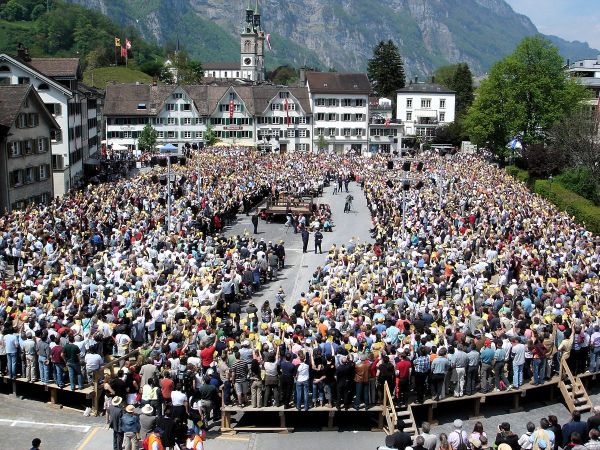 People's assembly in the county of Glarus. This is where laws, budget and county expenditure are debated and decisions are made directly and democratically. Any citizen can request the floor. This tradition is now 700 years old.Democracy needs citizens who participate and engage in public matters. The grumbling consumer-mentality does not produce lasting democracy, it favors democracy despising demagogues. In the history of mankind, no democracy lasted more than 250 years before relapsing into tyranny. Without the help of the United States, European democracies would have disappeared 80 years ago. Yet, direct democracy in Switzerland has a long history dating back to the 13th century. The mountain communities of central Switzerland had successfully fought the emperor's army. These mountain communities were then governed by popular assemblies and had developed the methods of democratic dialogue. That dialogue guaranteed their unity and independence from the Austrian Habsburg Empire. From the 14th century, the cities of Lucerne and Zurich imitated the mountain communities and built a mutual defense agreement with those communities. No other form of democracy has lasted so long without interruption.
People's assembly in the county of Glarus. This is where laws, budget and county expenditure are debated and decisions are made directly and democratically. Any citizen can request the floor. This tradition is now 700 years old.Democracy needs citizens who participate and engage in public matters. The grumbling consumer-mentality does not produce lasting democracy, it favors democracy despising demagogues. In the history of mankind, no democracy lasted more than 250 years before relapsing into tyranny. Without the help of the United States, European democracies would have disappeared 80 years ago. Yet, direct democracy in Switzerland has a long history dating back to the 13th century. The mountain communities of central Switzerland had successfully fought the emperor's army. These mountain communities were then governed by popular assemblies and had developed the methods of democratic dialogue. That dialogue guaranteed their unity and independence from the Austrian Habsburg Empire. From the 14th century, the cities of Lucerne and Zurich imitated the mountain communities and built a mutual defense agreement with those communities. No other form of democracy has lasted so long without interruption.
Communal intelligence: In 1907, the statistician Francis Galton made an interesting experiment. During an agricultural exhibition, he asked 800 volunteers to estimate the weight of a living ox on display. The mean value of the estimates was accurate by 1%, which an individual would only have achieved by chance. That's one case among many to show the intelligence of a group of people. Modern team-work is another form of communal intelligence.
In a culture of communal intelligence, a criticism has no more value than a counter-proposal to the criticized topic. With this in mind, the downloadable data and computations were made available in order to improve them together.
Conditions for collective intelligence
Different scholars have shown the value of collective intelligence among scientists, for example Isabell Stengers in her book "Une autre science est possible". In his book "The Wisdom of Crowds", James Surowiecki demonstrated the benefits of collective intelligence for management, financial markets and democracies. Collective intelligence produces better results than individual intelligence if it meets the following four conditions:
1) Diversity of opinion (each person should have some private information, even if it's just an eccentric interpretation of the known facts),
2) Independence (people’s opinions are not determined by the opinions of those around them),
3) Decentralization (people are able to specialize and draw on local knowledge),
4) Aggregation (some mechanism exists for turning private judgments into a collective decision) [1]. Swiss semi-direct democracy fulfills these conditions.
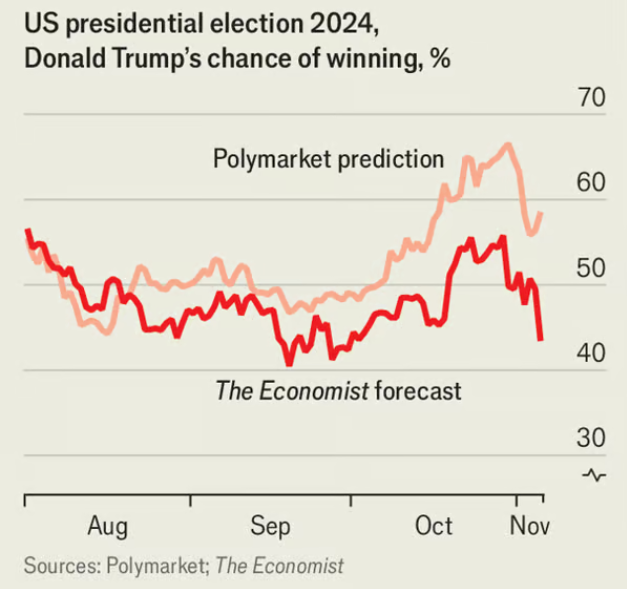 The Polymarket crowd made a preciser forecast than pollsters and pundits.The betting website Polymarket allowed anyone to bet about the US presidential election, choosing between D. Trump and K. Harris. The forecast of The Economist is usually one of the most reliable, yet the Polymarket crowd predicted the outcome of the election much better than did pollsters and pundits.
The Polymarket crowd made a preciser forecast than pollsters and pundits.The betting website Polymarket allowed anyone to bet about the US presidential election, choosing between D. Trump and K. Harris. The forecast of The Economist is usually one of the most reliable, yet the Polymarket crowd predicted the outcome of the election much better than did pollsters and pundits.
More recently, the users of Polymarket did a better job than other sources at predicting Israel's strikes on Iran. They did also a better job than polsters at predicting the result of New York's Democratic mayorial primary ! [2]
In direct democracy, if the subjects are suitable, scientists and other specialists participate in the development of arguments both with civil society and with Parliament, because more often than not, the best arguments win votes and intellectual laziness is punished at the ballot box. The fear that direct democracy is a form of "dictatorship of the demagogues" is unfounded. Switzerland is proof to the contrary since voting participation increases with the level of voters' education.
Direct democracy weakens some criticisms of representative democracy. Lobbies can influence or buy a few members of parliament, it is more difficult to buy a quarter of the population. Second, no Swiss political party dares to tell lies to win a vote like the outright lies told before the Brexit referendum. Such a lying political party would not be credible for a long time after the lies become obvious, like after the Brexit vote. With an average of eight votes per year, spread over three weekends, it is in the interest of politicians to remain credible in the long term. Before each vote, public television and radio organize debates, during which no one wants to be reminded of the previous lies. Could the Swiss democracy inspire other countries and contribute to get to net-zero-emissions with democratic means ? The purpose of these pages is to try to answer this question.
In order to compare the political cultures of Swiss and British citizens, this website proposes three Swiss votes, resulting from citizens' initiatives, with the arguments in favor and against each of the three bills. To start, we choose in the menu "Votes" the title of the desired proposition. After reading the proposed laws and the arguments in favor and against it, it is possible to vote "I vote for", "I vote against", "I have no opinion". If there are enough voters, the results can be compared with the vote in Switzerland and the press and the government may be informed about the results. But the Swiss citizens' initiative does not correspond to what some politicians are asking for France. In Switzerland, it is not possible to dismiss a politician or any other public person by referendum. It is only possible to make proposals for laws in accordance with the existing constitution. It is also possible to require a referendum for a law passed by Parliament.
For each citizens' initiative, the government can make a less extreme counter-proposal and put it to a vote at the same time. In Switzerland, the organizers have to formulate a proposal for a law and then collect 100 000 signatures within 18 months. Signatures and postal addresses are checked to see if the signatory has the right to vote. If the organizing committee of the citizens' initiative has respected the deadlines and the number of signatures, the bill must be submitted to a referendum, even if the government and Parliament are against it. The government and the Parliament can make a counter-proposal and submit it to a vote too. Proposals are accepted only if they win both the majority vote of the people and the majority of cantons, e.g., the proposal has to be accepted by at least 12 of the 23 cantons. Thus, a few large and populous cantons can't force their opinion on small rural cantons.
This website contains three voting-subjects of varying complexity.
Collective intelligence at work
The three propositions first give the text of the laws as it was sent to each citizen. Then, the arguments in favor and against the proposed law are developed. Usually the arguments "in favor" come from the organizing committee of the citizens' initiative, the arguments "against" most often come from the government and the majority of the parliament. Summaries of arguments are also sent to each voter. I chose three votes with three different levels of complexity. Readers will probably realize that people who do not like to think will not vote three time a year, which is not a problem for democracy and should reassure the government. Participation in complex subjects rarely exceeds 35%, but it is always more difficult for a lobby to "buy" a quarter of the population than "to buy" a few members of parliament. The system is therefore rather corruption resistant. 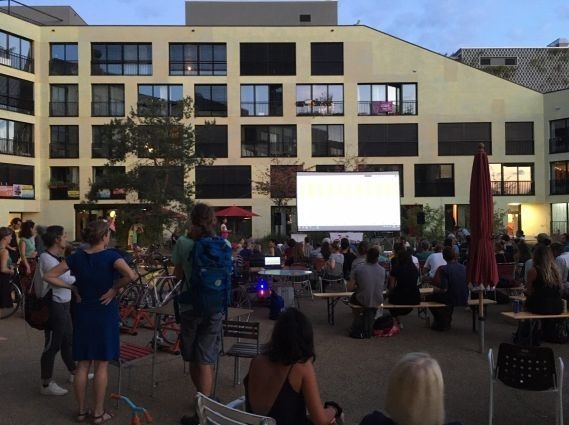 Information and debate before a referendum vote in the 2000-watt neighborhood called Kalkbreite.
Information and debate before a referendum vote in the 2000-watt neighborhood called Kalkbreite.
The citizens' initiative referendum could do good for the democracy of a country in which reasonable democratic debate has almost vanished and was replaced by name-calling and silly partisan criticism. In Switzerland, a criticism has no more value than the counter-proposal made to resolve the subject criticized. In Switzerland, the "full-time-critics" easily hear the answer "please start a citizens' initiative" or "what do you propose?". Even demagogues are forced to make concrete proposals, which puts them in a less comfortable position since their proposals can be criticized too.
Reaching net-zero carbon emission during the next 30 years will need plenty of propositions based on serious numbers and data. The figures and numbers given on this website should help to distinguish between demagogic green-washing propaganda and propositions that allow to reach the stated goal of net-zero.
Limits of a centralized government to reach net-zero-emissions
As shown in the book, centralized government can produce incentives for people to build better energy-efficient houses and offices. Carbon taxes may encourage companies to invest in renewable energy production. Centralized government can also encourage decarbonization of industrial processes such as steel production using hydrogen and electricity. SSAB, a Swedish steel company, has a large steel producing pilot-plant running that emits almost no CO2. Now, the company invests into a new bigger facility. However, as an IEA report from May 2021 shows, two thirds of CO2 reduction must be done by actively participating citizens that freely reduce their carbon footprint. A centralized democratic government has limited power to enforce drastic action on its citizens, many choices must come from the citizens themselves. Such choices can be implemented if a majority of citizens vote propositions in local referendums. In order for citizens to vote for carbon reducing propositions, they need practical examples such as 2000-watt neighborhoods. State bureaucracy must also show that they reduce their sometimes lavish living standards.
Sometimes a mayor or a governor behaves like a local god, spending lavishly other people's money on high profile projects, in total contradiction to the announced net-zero goal. For the good health of a democracy, it is therefore also desirable that high expenditure can be voted on by those who pay, the citizens. Elected officials automatically become more reasonable if they risk a setback at the ballot box for an expense deemed unnecessary or disproportionate. The citizens' initiative should therefore be able to ask for two things:
1) Demand a popular vote for a law passed by Parliament or for an expenditure voted by a municipal Council or a regional government.
2) Citizens' initiative should be able to propose a more or less precise framework law. If the proposition was accepted by a referendum vote, the details are then discussed and voted on by the (state) Parliament.
For each citizens' initiative referendum, the government can make a less extreme counter-proposal and put it to a vote at the same time. In Switzerland, it is necessary to formulate a proposal for a framework law and then, after verification of the constitutionality of the proposal, collect 100 000 signatures within 18 months. Signatures and addresses are checked to see if the signatory has the right to vote. This threshold of 100 000 signatures prevents about one in two citizens' initiatives from succeeding and being submitted to parliament and to a referendum. If the organizing committee of the citizens' initiative has respected the deadlines and the number of signatures, the bill must be submitted to a referendum, even if the government and Parliament are against it. But the government and Parliament can make a less extreme counter-proposal and put it to a vote as well. The number of signatures should be proportionate to the number of citizens of a country or state.
The Swiss recently voted in a referendum on a law to significantly reduce CO2 emissions until 2030. I have chosen not to propose a vote on this referendum on this website, because this law contains 53 articles and fills 70 pages. However, it is possible to download the bulletin that each Swiss citizen received before the vote. The booklet (in French) gives an idea of the complexity of certain subjects that the Swiss people discuss and vote about :
Votation-populaire-loi-CO2-13-juin-2021.pdf![]() 398.26 Ko
398.26 Ko
Vote proceedings
The three sub-menus first give the text of the law of each citizens' initiative as it was sent to each voter and put to the vote. Then, the arguments in favor and against the proposed law are developed. Usually the arguments in favor come from the organizing committee of the citizens' initiative, the arguments against it most often come from the government and the majority of the parliament. Summaries of arguments are also sent to each voter. I chose three votes with three different argumentative difficulty levels.
Usually, the debate is about giving a weight to each argument, rather than claiming that others' arguments are false. Sometimes the arguments are based on false data and if the data is corrected the weight of the argument is significantly reduced. The first debate should therefore allow the debaters to agree on the data. Then, in the process of weighing each argument, we usually find the philosophy of the person making the argument. Growing up and living with this kind of debates for a lifetime brings citizens closer to scientific methods and reduces the proportion of the population who subscribe to implausible conspiracy theories and "steal the vote" propaganda.
Without a culture of reasonable debate, democracy will probably move to chaos, followed by either state-oppression or a surveillance-state. Without a culture of reasonable contradictory debate, the terrible vision of society, described by Denys de Béchillon, French professor of public law, risks becoming reality:
"Whether we like it or not, half of the people - of this people who inspire the morals of the planet and which we should not believe is not like us - has made egoism its creed, renunciation of intelligence its principle, irresponsibility its rule and obscenity its style."( L'Express, December 16th, 2020).
This site hopes to demonstrate that this law professor is wrong and that another democratic outcome is possible.
At the start of the revolt of the yellow vests in France, before they brought violence to the big urban centers, I went to meet them on the roundabouts. There, I attended quieter and more reasonable debates than in some student meetings in the universities, although the discussions on the roundabouts were less eloquent. For a very long time, some students from the upper middle classes have been attracted to totalitarian ideologies (the ideologies of the Soviet Union and Maoism, Enver Hodja and Pol Pot, and today the Salafists), while the yellow vests asked for more democracy in the form of citizens' initiatives and referendums. That should not come as a surprise. In the 14th and 15th centuries, the democracy of the Swiss cantons was obtained by the struggle of the mountain peasants, not by the privileged classes of big cities like Zurich. The ruling and privileged classes of Zurich preferred the German princes to the democratic cantons "of deplorable poor mountain peasants", which are at the origin of the Swiss direct democracy. It is therefore not surprising that those who suffer most from the abuses of power by the powerful also demand more direct democracy in the form of citizens' initiatives and referendums.
Footnotes
[1] ˄ James Surowiecki, The Wisdom of Crowds, page 10. The author gives interesting and relevant examples in different fields. In "Crowd Psychology", Gustave le Bon shows the crowds are easily manipulated by demagogues. That type of crowds do not meet any of the four criteria mentioned by Surowiecki.
[2] ˄ The Economist, Prediction markets are soaring in popularity. With a few tweaks, thet could really take off; June 28th 2025




